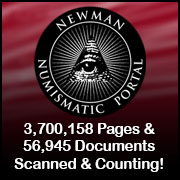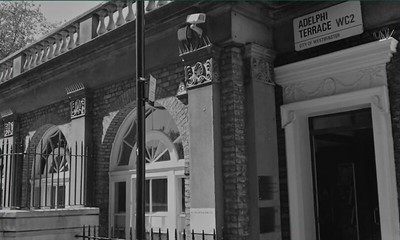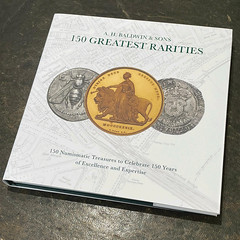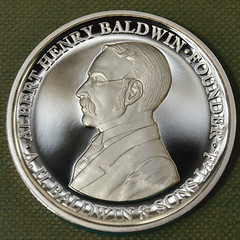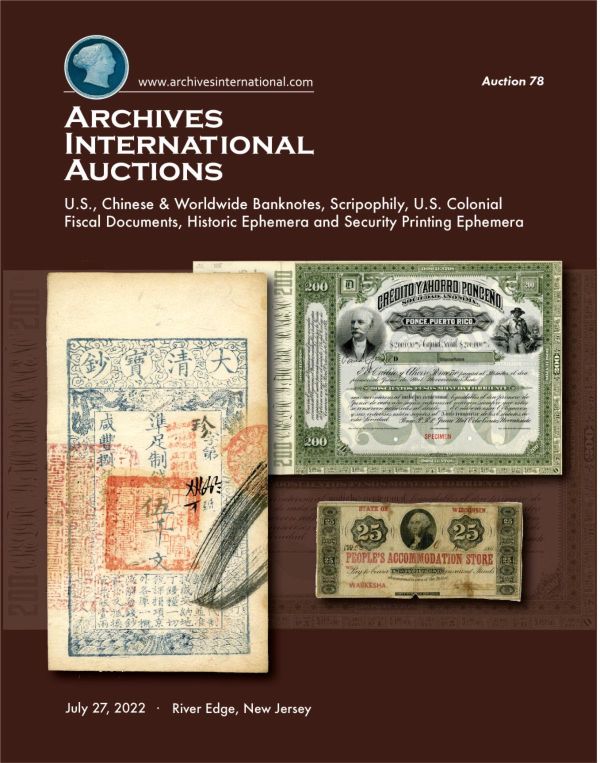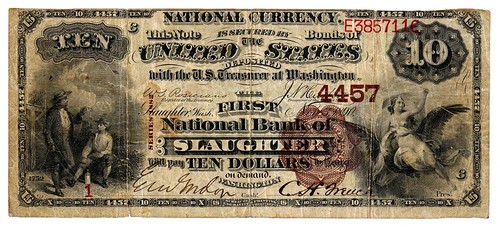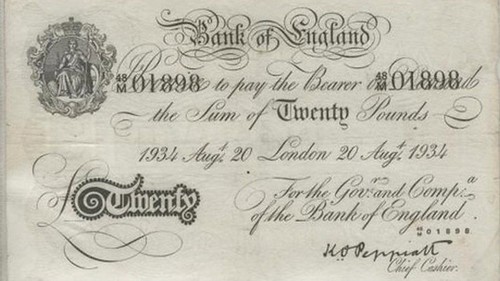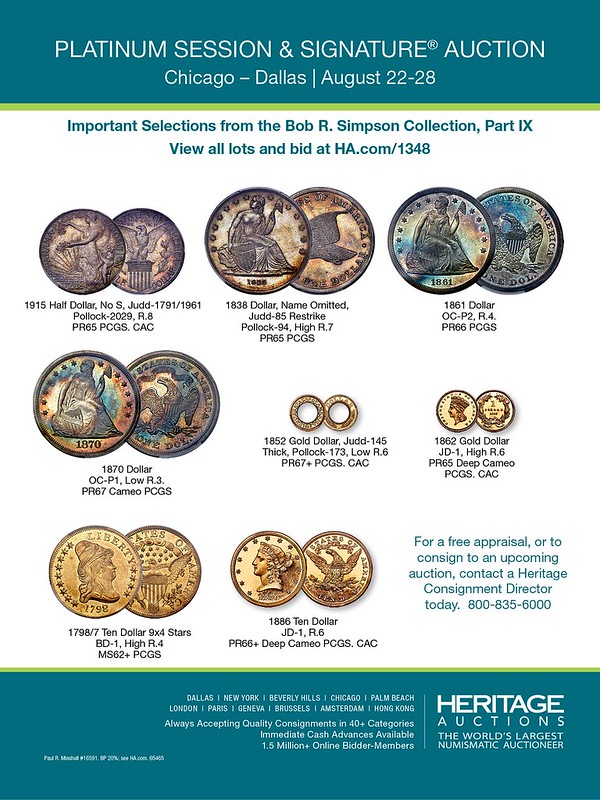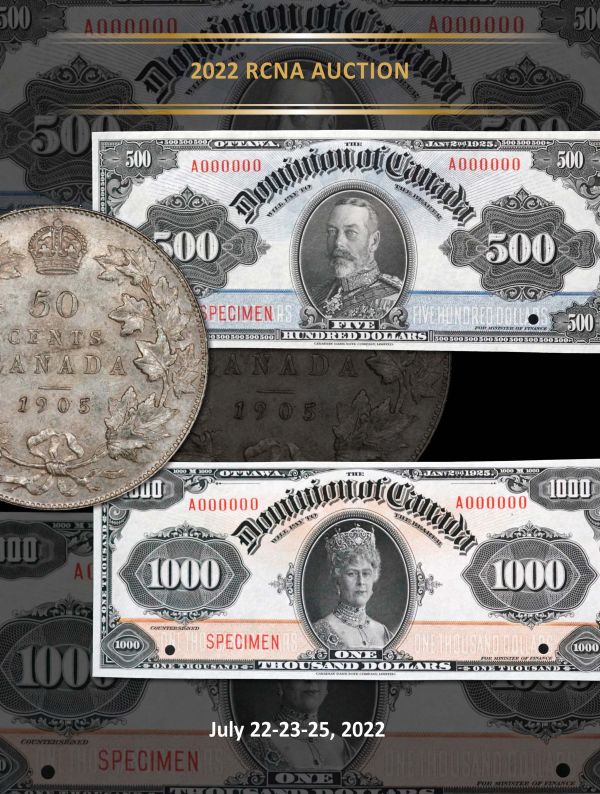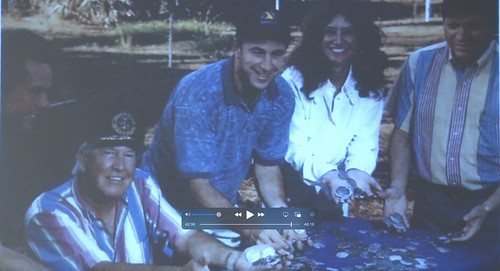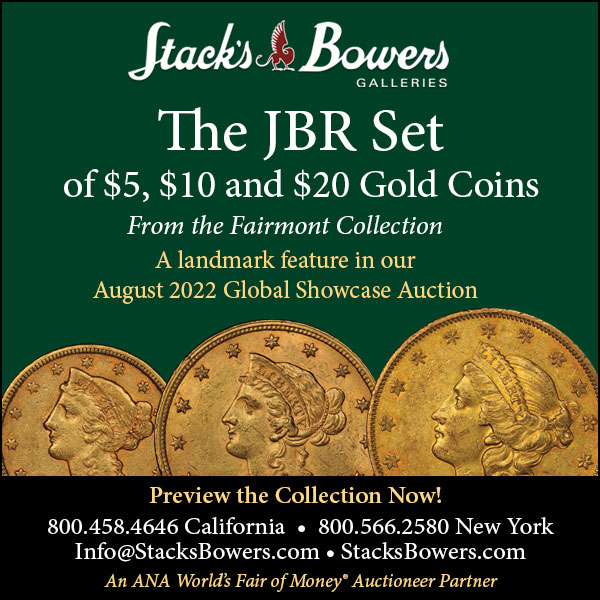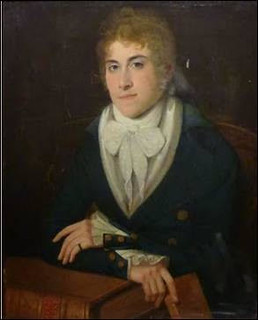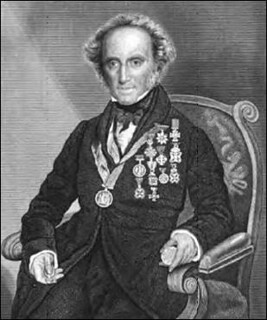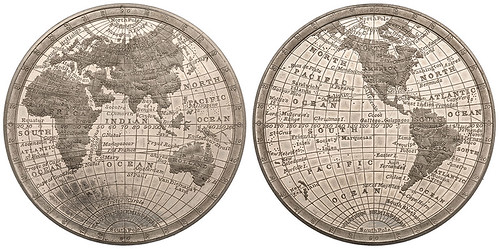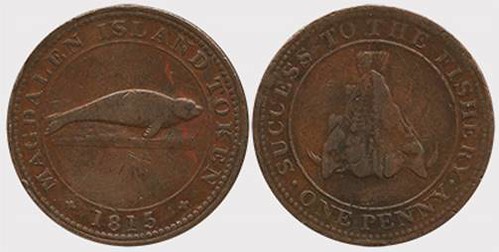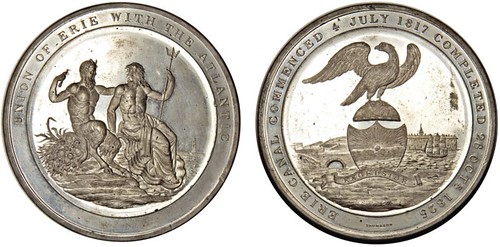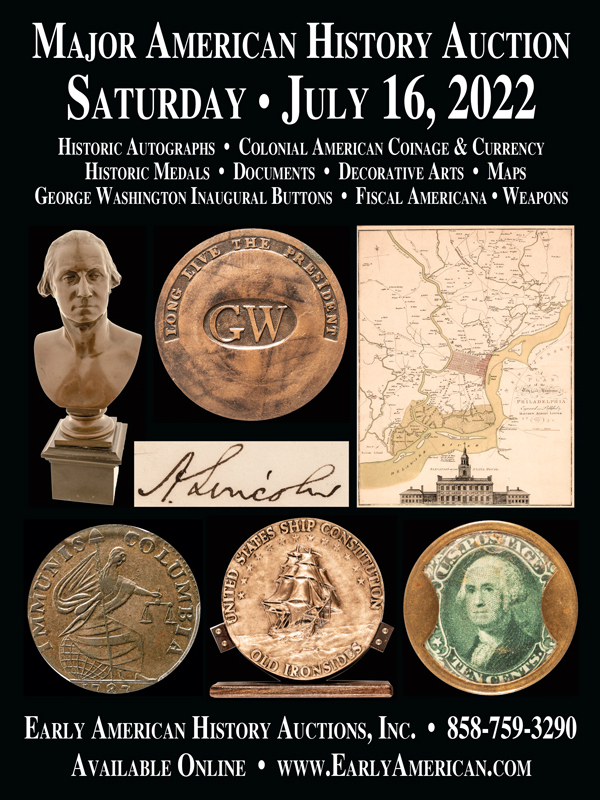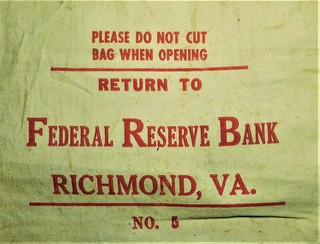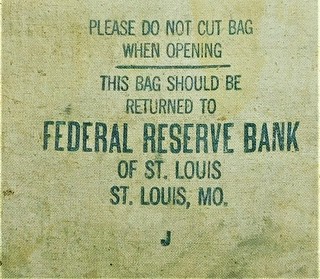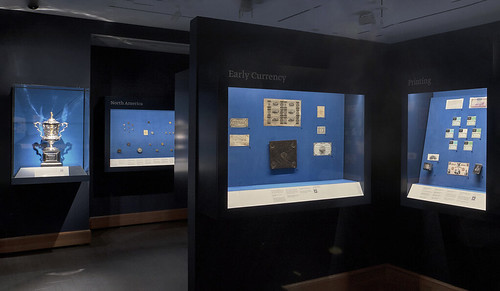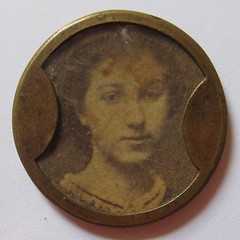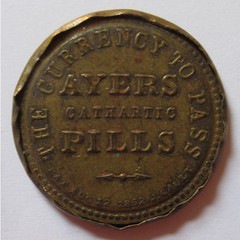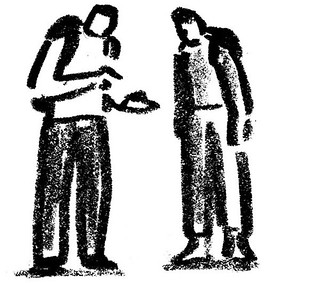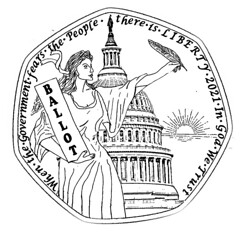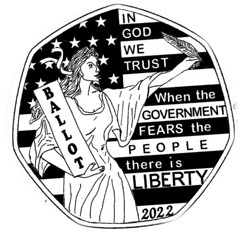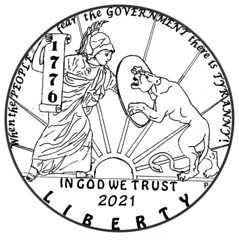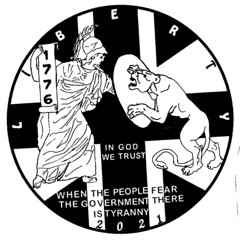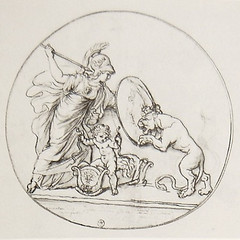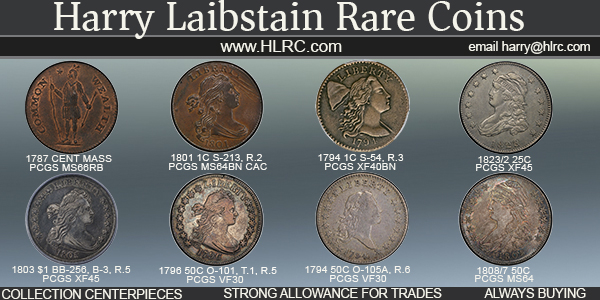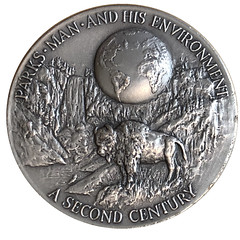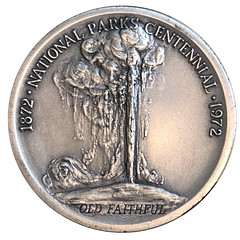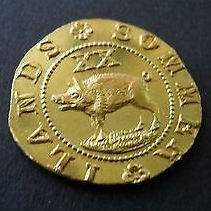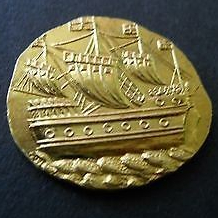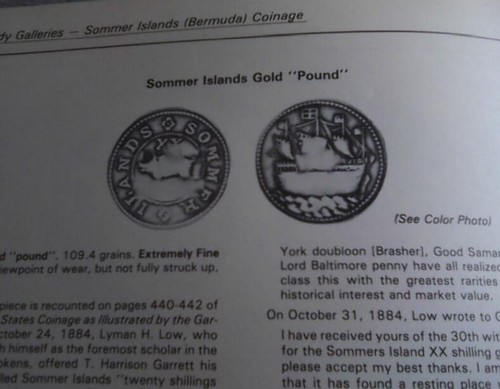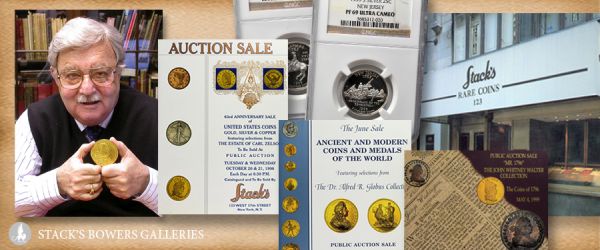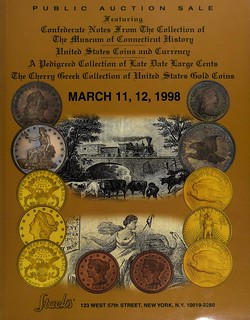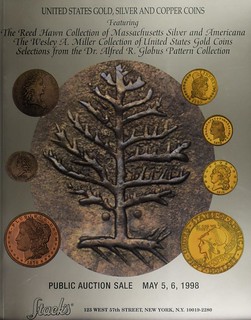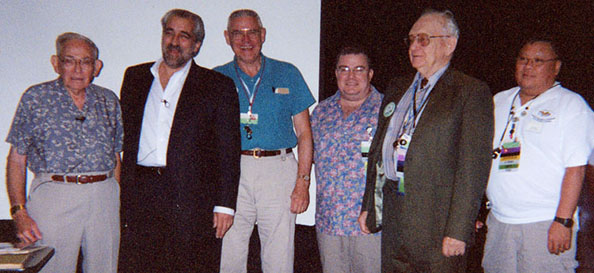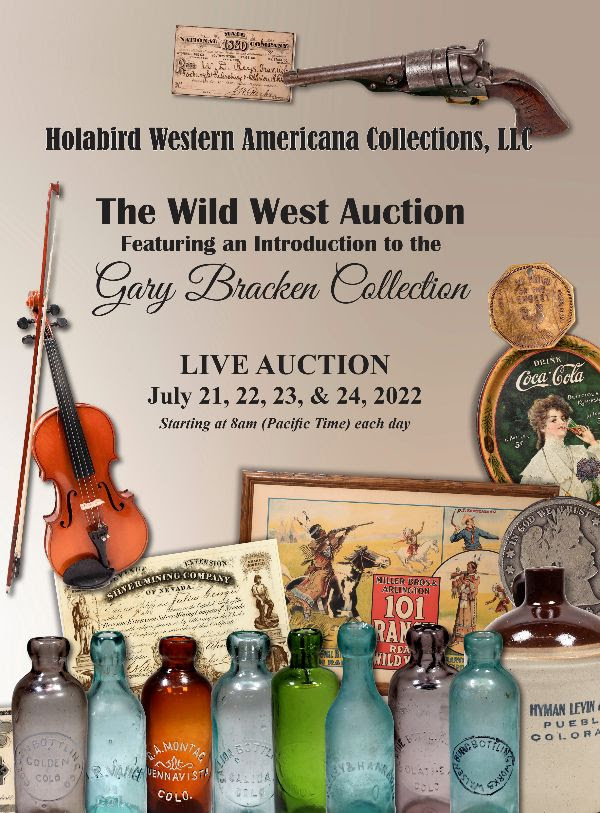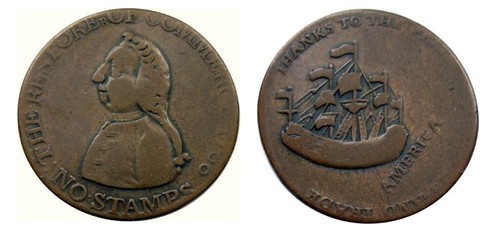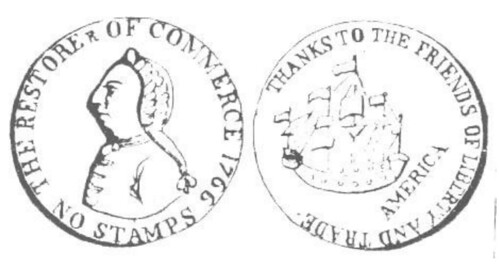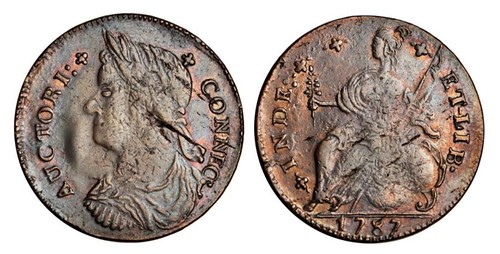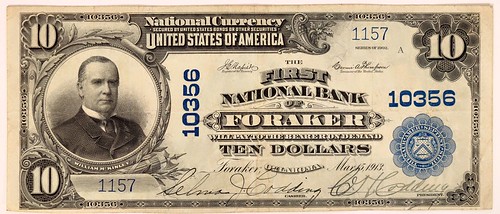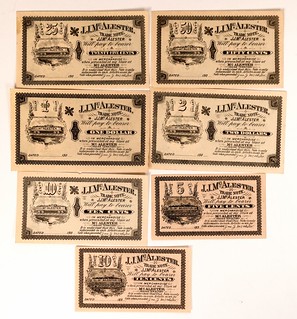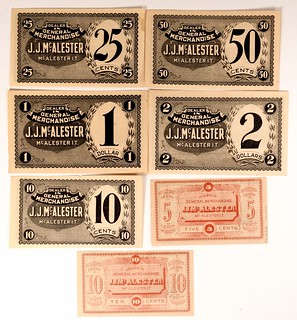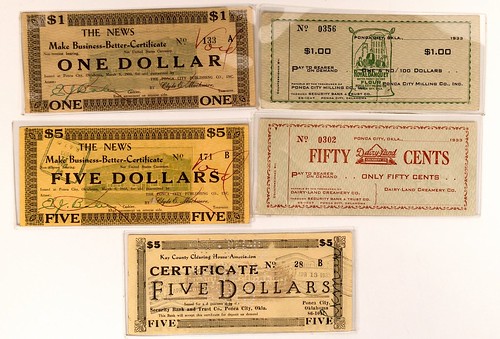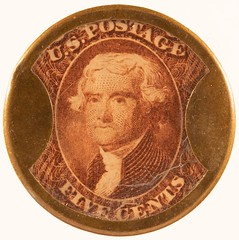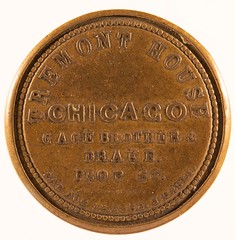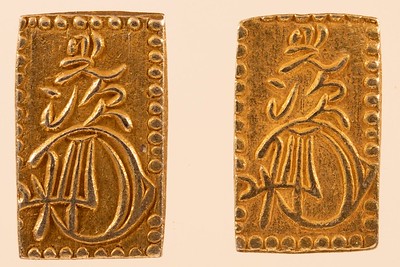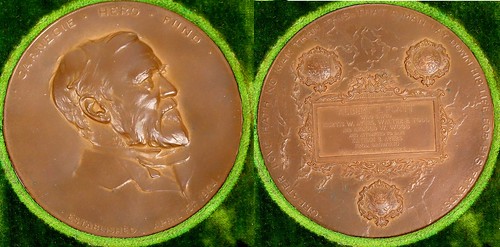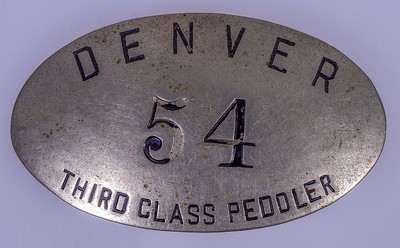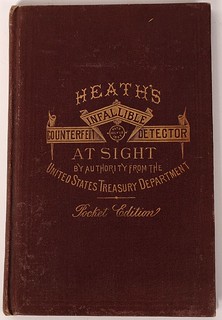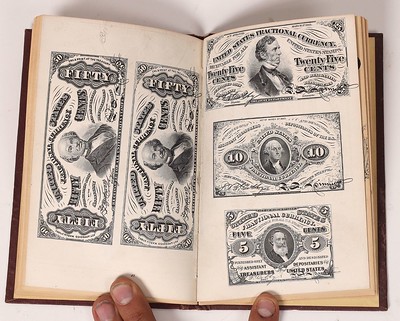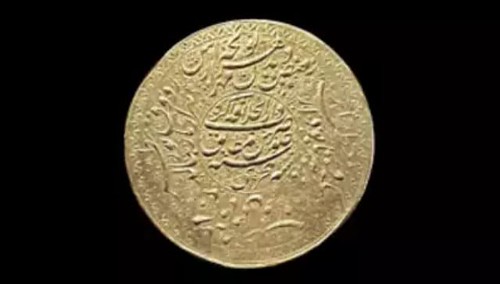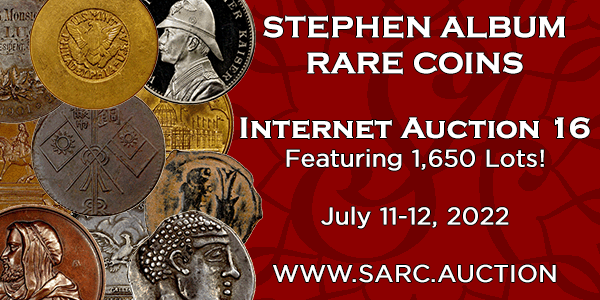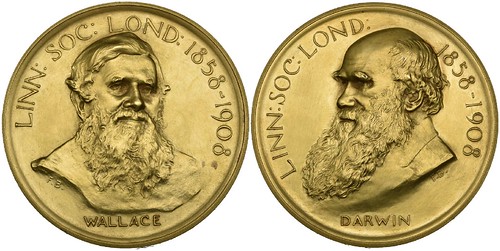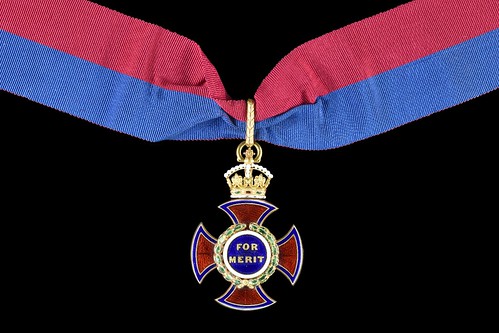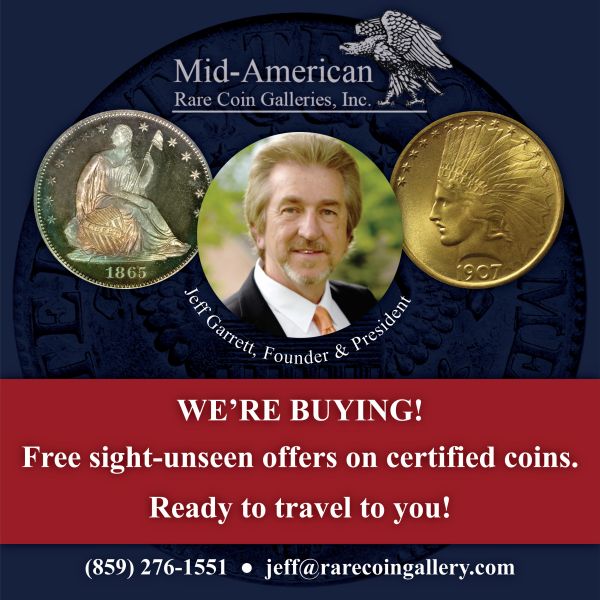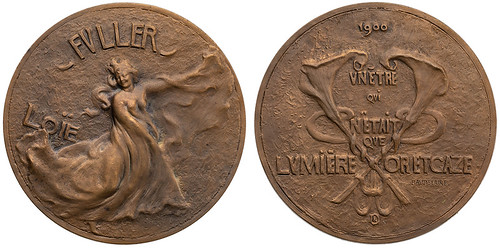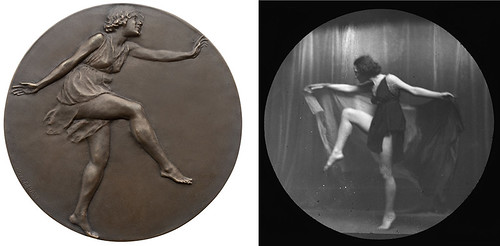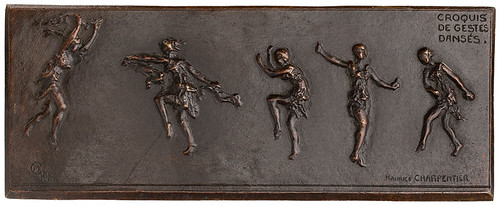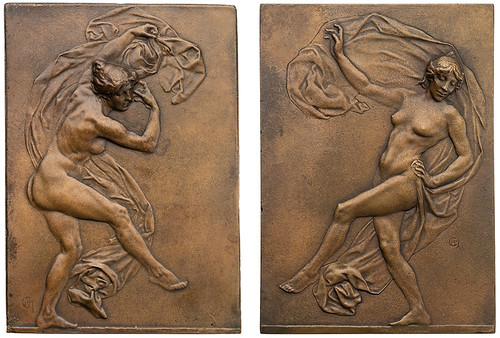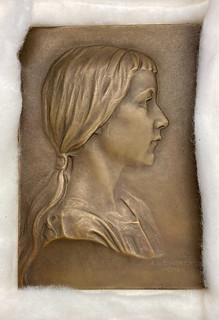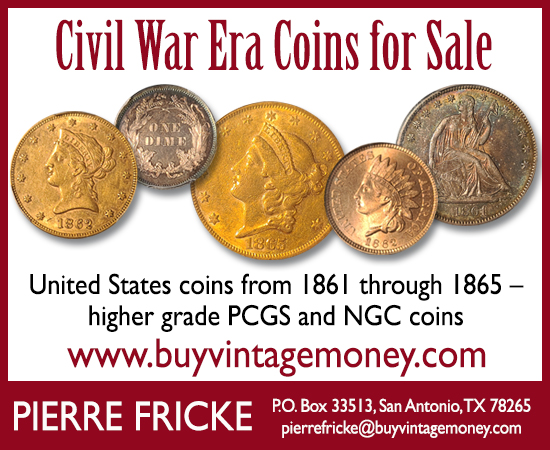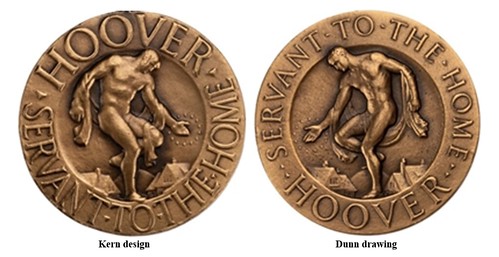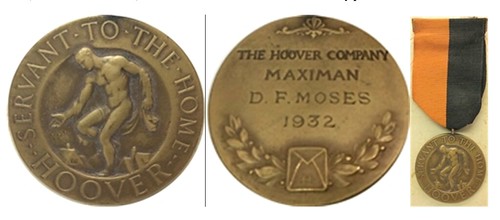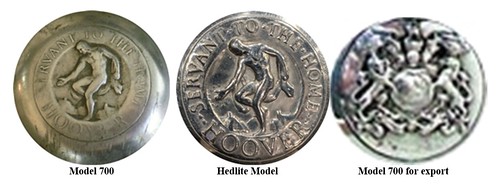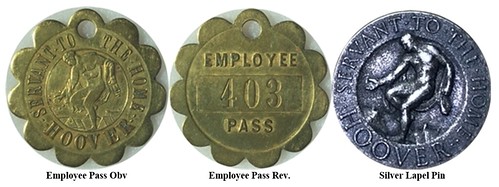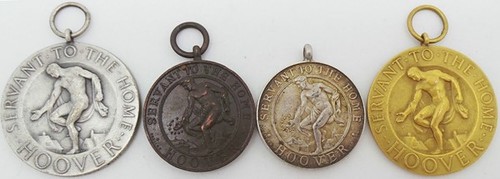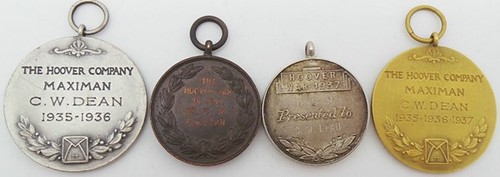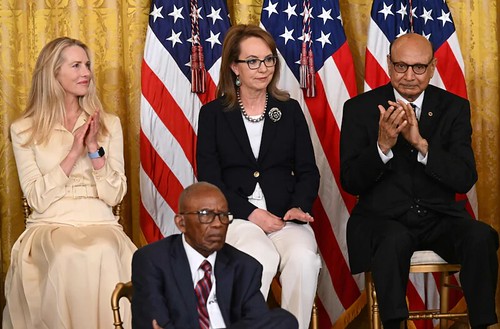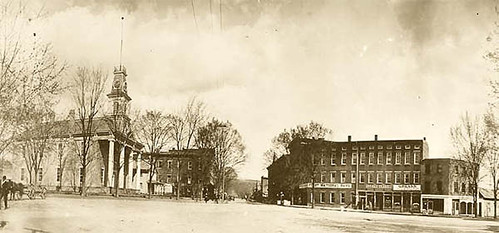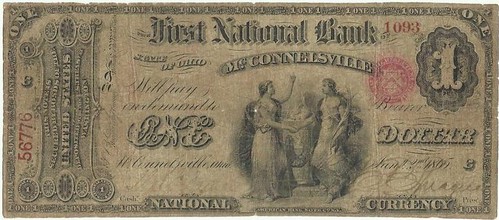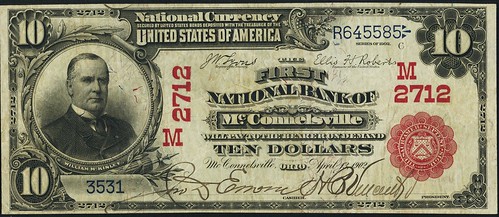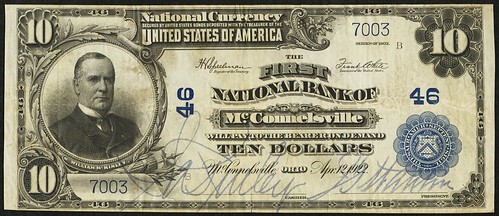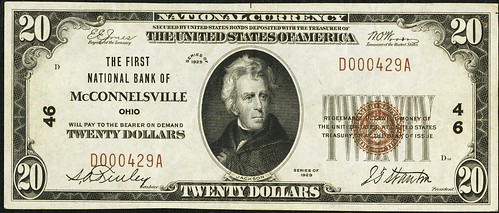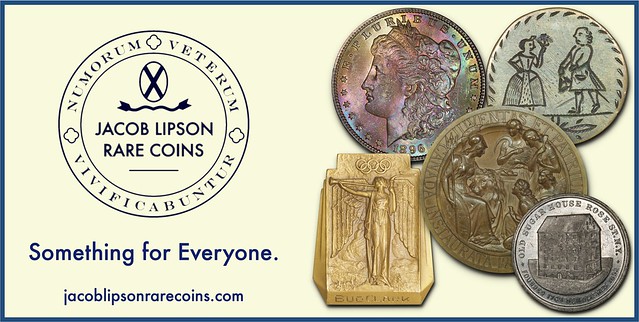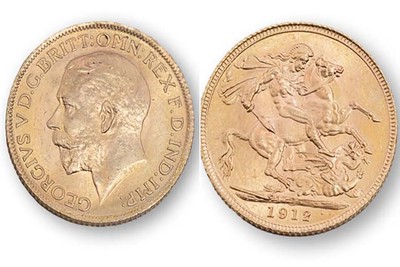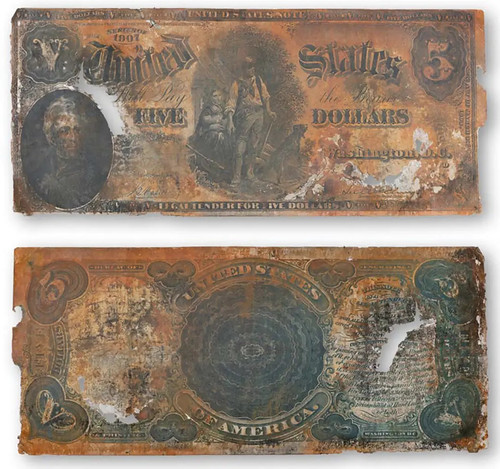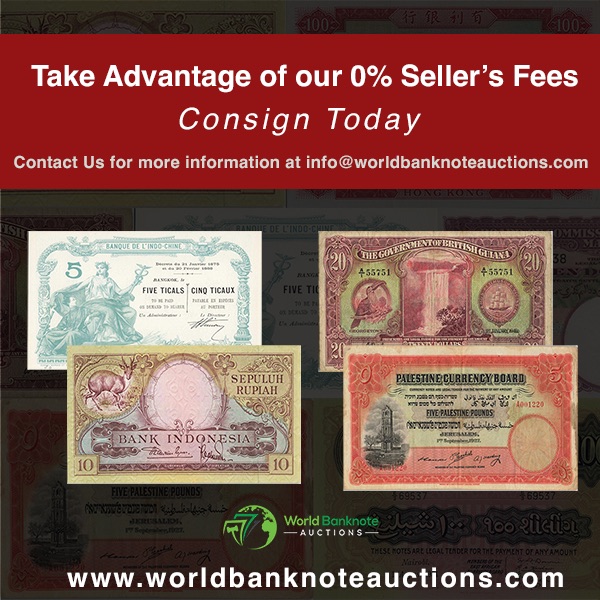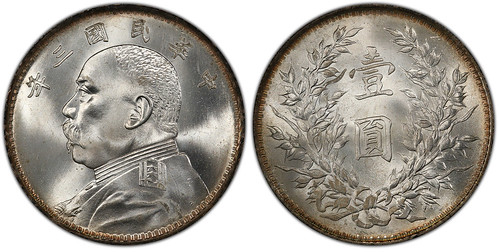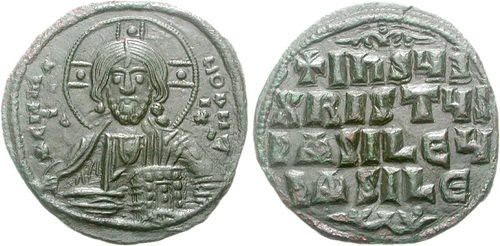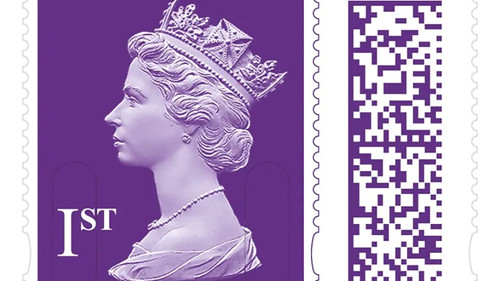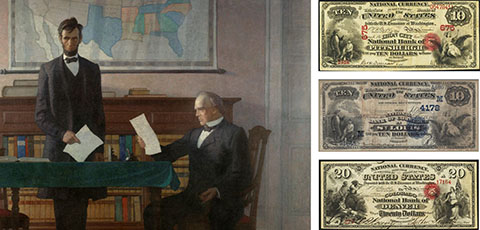
Visit our NBS Sponsors



About UsThe Numismatic Bibliomania Society is a non-profit association devoted to the study and enjoyment of numismatic literature. For more information please see our web site at coinbooks.org SubscriptionsThose wishing to become new E-Sylum subscribers (or wishing to Unsubscribe) can go to the following web page link MembershipThere is a membership application available on the web site Membership Application To join, print the application and return it with your check to the address printed on the application. Print/Digital membership is $40 to addresses in the U.S., and $60 elsewhere. A digital-only membership is available for $25. For those without web access, write to: Charles Heck, Treasurer AsylumFor Asylum mailing address changes and other membership questions, contact Chuck at this email address: treasurer@coinbooks.org SubmissionsTo submit items for publication in The E-Sylum, write to the Editor at this address: whomren@gmail.com BUY THE BOOK BEFORE THE COINSale Calendar |
- WAYNE'S WORDS: THE E-SYLUM JULY 10, 2022
- NEW BOOK: BALDWIN'S 150 GREATEST RARITIES
- NEW BOOK: ENCYCLOPEDIA OF U. S. NATIONAL BANK NOTES
- NEW BOOK: FORGING SECRETS
- RICHARD REED HAWN (1949-2022)
- BIBLIOGRAPHY OF NUMISMATIC AUCTION CATALOGS
- NEWMAN PORTAL ADDS BILL RAU'S PATTERN DATABASE
- VIDEO: STORY OF THE LA CAPITANA
- MORE ON THOMASON'S SCIENTIFIC MEDALS
- NOTES FROM E-SYLUM READERS: JULY 10, 2022
- COIN DESIGNS CELEBRATING FREEDOM
- VOCABULARY TERM: KEYNOTE, KEYSTONE
- THE SOMMERS ISLAND FRAUD
- HARVEY STACK'S NUMISMATIC FAMILY, PART 125
- FRED WEINBERG INTERVIEW, PART ONE
- MORE ROSA AMERICANA PRICE LIST #23 SELECTIONS
- HOLABIRD JULY 2022 SALE SELECTIONS
- INDIA HUNTS FOR WORLD'S BIGGEST GOLD COIN
- ROYAL MINT HONORS ALAN TURING
- MORTON & EDEN OFFER ALFRED WALLACE MEDALS
- MEDALLIC REPRESENTATIONS OF DANCE
- ALBERT WEINERT AND BAUMAN BELDEN
- HOOVER SERVANT TO THE HOME MEDALS
- 2022 FIELDS MEDAL WINNERS
- 2022 MEDALS OF FREEDOM AWARDED
- STOLEN GOLD MEDAL RETURNED TO OLYMPIAN
- THE FIRST NATIONAL BANK OF MCCONNELSVILLE
- TITANIC COIN AND PAPER MONEY DISPUTED
- LOOSE CHANGE: JULY 10, 2022
- ROYAL MAIL ADDS BARCODES TO STAMPS
- FEATURED WEB SITE: COMPTROLLER OF THE CURRENCY
Click here to read the thin version on the web
Click here to subscribe
Click here to access the complete archive
To comment or submit articles, reply to whomren@gmail.com
Content presented in The E-Sylum is not necessarily researched or independently fact-checked, and views expressed do not necessarily represent those of the Numismatic Bibliomania Society.
WAYNE'S WORDS: THE E-SYLUM JULY 10, 2022
 New subscribers this week include:
David Carpenter, courtesy Judy Blackman;
Robin Clay and Megan Pellegrino, courtesy Harry Waterson;
Emma Howard of SPINK, courtesy Helen Wang;
Whitney Nakata, courtesy Kellen Hoard;
Thanks also to Tom DeLorey for an additional new subscriber.
Welcome aboard, everyone!
New subscribers this week include:
David Carpenter, courtesy Judy Blackman;
Robin Clay and Megan Pellegrino, courtesy Harry Waterson;
Emma Howard of SPINK, courtesy Helen Wang;
Whitney Nakata, courtesy Kellen Hoard;
Thanks also to Tom DeLorey for an additional new subscriber.
Welcome aboard, everyone!
Thank you for reading The E-Sylum. If you enjoy it, please send me the email addresses of friends you think may enjoy it as well and I'll send them a subscription. Contact me at whomren@gmail.com anytime regarding your subscription, or questions, comments or suggestions about our content.
This week we open with three new books, updates from the Newman Numismatic Portal, notes from E-Sylum readers, and more.
Other topics this week include Reed Hawn, Bill Rau's pattern database, the La Capitina shipwreck, Thomason's scientific medals, keystone medals, the Sommers Island gold pound, Alan Turing, Alfred Wallace, Bauman Belden, Servant to the Home medals, the Medal of Freedom, coins and paper money from the Titanic wreck, and the oldest national bank still operating under the same original name and Office of the Comptroller Charter number.
To learn more about the Baldwin's sesquicentennial, U. S. National Bank Notes, Operation Bernhard counterfeits, the Magdalen Islands token,
Federal Reserve bank bags, Hillbilly Handfishing, Fred Weinberg, the Connecticut Snipe Nose
Copper, Make Business Better scrip, the missing 1,000 tola gold coin, a medal inspired by Isadora Duncan, carpet beaters, and the Fields medal, read on. Have a great week, everyone!
Wayne Homren
Editor, The E-Sylum
THE BOOK BAZARRE
NEW BOOK: BALDWIN'S 150 GREATEST RARITIES
Chip Howell passed along this YouTube video announcing a new book produced by A.H. Baldwin & Sons (London) on the occasion of the firm's 150th anniversary. Although there is no information on their website, they say the book will be available in late July. Thanks. -Editor
To watch the video, see:
Celebrating 150 years of Baldwin's Coins | Baldwins Coins
(https://www.youtube.com/watch?v=k0XGJIaXlYg)
In their July 8 emailing of The Baldwin's Bulletin, the company invited readers to reserve a copy of the book or a new medal commemorating the anniversary. -Editor
Limited Edition Medallion & A Brand New Book!
300 limited edition commemorative medallions have been minted to mark 150 years of Baldwin's. We have also published a new book, 'Baldwin's 150 Greatest Rarities'. Secure yours today by emailing us detailing which you'd like to pre-order.
To email Baldwin's, see:
coins@baldwin.co.uk
NEW BOOK: ENCYCLOPEDIA OF U. S. NATIONAL BANK NOTES
Here's the announcement for a long-awaited book - the Encyclopedia of U. S. National Bank Notes. -Editor
It is with excitement that Andrew Shiva announces the release of the Encyclopedia of U. S. National Bank Notes published jointly by his National Currency Foundation and the Society of Paper Money Collectors.
The encyclopedia is huge, currently containing some 1,500 pages, 1,400 illustrations and 210 tables divided into 144 chapters organized into 17 topical sections.
The encyclopedia is too large and would be too costly to publish in print form so it is being made available in digital form through both the National Currency Foundation and Society of Paper Money websites.
Both the NCF and SPMC have educational commitments to disseminate information that promotes the research and collecting of paper money; thus, publication of the encyclopedia affords a natural collaboration that furthers this objective for both organizations. Preparation of the encyclopedia has been largely sponsored by the NCF and details of maintaining it on line have been assumed by the SPMC. It is presented free of charge as a service to not only numismatists but the public at large.
The encyclopedia covers every aspect of national bank notes from why they originated during the Civil war to why they were phased out 72 years later. As for the notes themselves, an explanation is provided for why there were different series and backs. The protocols are explained that governed how every other design element on the notes functioned and evolved over time. Much of this was dictated by Congressional legislation, the rest by decisions made by Treasury officials as the national bank note era unfolded.
The encyclopedia represents a significant part of the life work of U. S. currency researcher Peter Huntoon, who has been writing about national bank notes since 1966. Over the intervening decades, he has collaborated with the leading national bank note researchers and collectors to coauthor this treatise.
The core of most of the encyclopedia represents original research that Huntoon and his colleagues have conducted using primary Treasury documents now preserved in the National Archives and at the Bureau of Engraving and Printing. A major resource that they used were the certified proofs lifted from the printing plates that were used to print national bank notes now housed in the National Numismatic Collection in the Smithsonian Institution.
A significant fraction of the information in the encyclopedia builds on material already published elsewhere, primarily in the SPMC journal Paper Money. However, much has never been released before. All of it has been reworked, updated and corrected based on the most recent research available. One major value of the encyclopedia is that it conveniently assembles all of this material in one place.
The arrangement of the subject matter into chapters within topical sections allows for the addition of new chapters as they are written. Equally significant is that by making it available digitally, updates and corrections can be made in real time as new information and insights are developed and mistakes—even typos— are discovered. To this end, a version date is provided at the bottom of the first page of each chapter. The encyclopedia is designed to be a dynamic work in progress.
This link will take you to the encyclopedia.
https://content.spmc.org/wiki/Encyclopedia_of_U.S._National_Bank_Notes
Click on Search the Table of Contents, read or download chapters
Click on any chapter of interest to read or down load it.
A few chapters have internal hot links to large tables or photo files.
NEW BOOK: FORGING SECRETS
The MPC Gram is an email newsletter for collectors of Military Payment Certificates and other military numismatica. This week it contained an announcement for a new book on the Operation Bernhard counterfeits of WWII. I hope to have more information on the book in a future issue. The following is adapted from the MPC Gram and invites interested parties to a book launch event at the upcoming ANA convention. -Editor
The Spungen Foundation will celebrate the release of an important new book, Forging Secrets, with a dinner event at this year's World's Fair of Money®. Forging Secrets tells the story of Operation Bernhard, the Nazi counterfeiting scheme which used concentration camp prisoners to forge Bank of England notes in an effort to destabilize the British economy during World War II.
This book is one-of-a-kind, both in look and content. It features a die-cut cover, special insert sleeves for Operation Bernhard notes, and sixteen different authors, aided by an army of researchers, translators, and volunteers. (The sixteen contributors include editor and contributor Joseph E. Boling, James Downey, Ray Feller, Steve Feller, Fred Schwan, Danny Spungen and Kiel Majewski).
This book will expose audiences old and new to the faces and facts inside this secret Nazi scheme. In fact you will be meeting some very incredible people including descendants related to Operation Bernhard.
Your keynote speakers and panelists for the evening will include Charlotte Krüger, granddaughter of Bernhard Krüger, the Nazi SS officer in charge of Operation Bernhard; and Debbie Walter daughter of Hans Walter, one of the forgers of Operation Bernhard.
Space is very limited and an RSVP is requested.
Please RSVP by Wednesday, July 27 by email to Creative Operations Ambassador Mikayla Hoppe (mikayla@spungenfoundation.org)
or online:
https://forms.gle/ZXLEWUaFHBKrT52U9
.
For more information on the Spungen Foundation, see:
www.spungenfoundation.org
RICHARD REED HAWN (1949-2022)
Ken Bressett alerted me to the passing of collector Reed Hawn. American Numismatic Biographies author Pete Smith kindly submitted this article on Reed and his father William. Thanks, everyone! -Editor
William Hawn was born in Butler County, Nebraska on April 12, 1918, the son of Texas geologist and oilman Richard Hugh Hawn (1895-1947) and Dorothy Hewitt Blakenay (1896-1967).
Hawn married Esther Jane Roark (1919-1976) on July 13, 1940. She was a sorority girl frequently mentioned in the society pages. They had two sons and were divorced on January 2, 1975. His second wife was Juanita Dial Carson Brown (1922-2012).
Hawn studied geology at the University of Texas. He went into the ranching business in 1945 and began raising Arabian horses in 1962. Hawn and two brothers inherited an oil business from their father and operated as Hawn Brothers.
He died in Oklahoma City on May 1, 1978, and is buried at Rose Hill Burial Park at Oklahoma City.
William was a coin collector who passed that interest on to his son. It appears that the 1973 Hawn auction had a significant portion from the collection of the father. Reed also benefited from the oil and gas business and Arabian horse ranch built by the father.
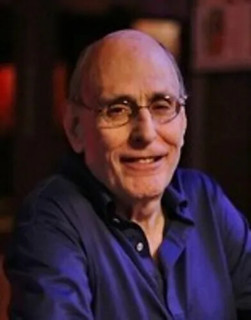 Reed Hawn was born on August 20, 1949, in Corpus Christi, Nueces County, Texas, the son of William Hewitt Hawn and Esther Jane Roark.
Reed Hawn was born on August 20, 1949, in Corpus Christi, Nueces County, Texas, the son of William Hewitt Hawn and Esther Jane Roark.
Hawn began collecting coins at age nine in a way familiar to many of us. He looked through circulating coins and put them into Whitman holders.
Hawn grew up riding in horse shows. His family was active in Corpus Christi society. When he was seventeen, he escorted a young lady to a debutante ball. Also when he was seventeen, he visited Stack's and began a long business relationship with the firm. He bought from their stock and participated in their auctions.
He received an A.A. degree from Del Mar College in 1969, and received a B.A. from University of Texas in 1971.
Hawn was married to Margaret Ann Redfearn on November 2, 1972. They had three children.
He joined the ANA in 1974 as member R-81601. His address was shown as Hawn Arabian Ranch in Sisterdale, Texas. He was a generous contributor to the ANA.
Hawn collected coins that were high grade and sometimes the finest known. He consigned coins to Stack's for auction on August 28-29, 1973, when he was just 24 years old. The catalog stated that it was assembled across the span of five decades.
For most coins no pedigree was given but we might assume the collection was built, in part, by the father.
Twenty years later Hawn consigned to a Stack's sale on October 13-14, 1993. The cover illustrated the two most notable coins, an 1804 dollar and a 1913 Liberty Nickel.
Hawn acquired the Mickley
1804 silver dollar from Stack's in January 1974 for $150,000. It was lot 735 in the 1993 sale and sold for $475,000.
He acquired the 1913 Liberty Nickel at Superior's Jerry Buss collection sale of January 28, 1985, lot 366. It was lot 245 in the Stack's 1993 sale.
In 1994 he was appointed to the Citizens Coinage Advisory Committee. Then in 2009 he was considered as a candidate for Director of the Mint. He said that, if appointed, he would reduce the number of commemorative issues and improve customer service.
Reed Hawn died on June 29, 2022.
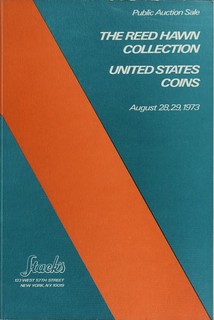

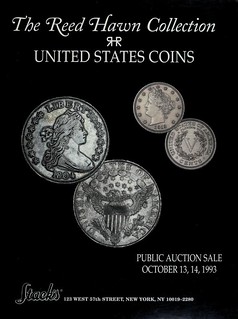
A 1974 syndicated story appeared in at least ten newspapers. It reported, Right after New Year's Day, Reed Hawn laid out $150,000 for a dollar.
And a little later, Now comes Reed Hawn to plunk down a record wad for Joe Bickley's rare 1804 dollar.
And still later, Hawn now holds the record for the most preposterous sum paid anywhere by anyone for an American coin.
Joe Bickley is not mentioned in the Newman/Bressett book on The Fantastic 1804 Dollar. He is not mentioned in the Bowers book on the 1804 dollars. In fact, Bickley does not show up anywhere on the Newman Numismatic Portal.
The preposterous price record held until May when a 1907 high-relief double eagle sold at Stack's for $200,000.
Smarty-Pants question of the week: Who was Joe Bickley?
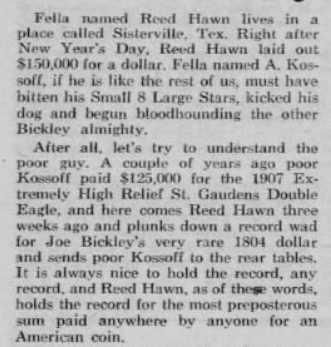 The first publication of this text seems to be an article in the Nassau edition of Newsday January 23, 1974 where columnist John Pascal interviews M. H. Rubenstein of M. H. Rubenstein Co. "in Bay Shore, one of Long Island's bigger coin emporiums." A Newman Numismatic Portal search indicates Rubenstein advertised extensively in Coin World from about 1967 through 1982. Pete adds that "Martin H. Rubenstein of BayShore, New York, was born on April 27, 1938, and died on November 29, 2004."
The first publication of this text seems to be an article in the Nassau edition of Newsday January 23, 1974 where columnist John Pascal interviews M. H. Rubenstein of M. H. Rubenstein Co. "in Bay Shore, one of Long Island's bigger coin emporiums." A Newman Numismatic Portal search indicates Rubenstein advertised extensively in Coin World from about 1967 through 1982. Pete adds that "Martin H. Rubenstein of BayShore, New York, was born on April 27, 1938, and died on November 29, 2004."
Can anyone tell us more about this Joe Bickley reference or Rubenstein himself? Little other than his ads is found in NNP. -Editor
To read the complete Reed Hawn online obituary, see:
Richard Reed Hawn
(https://www.statesman.com/obituaries/paco0245386)
To read the complete M. H, Rubenstein interview, see:
https://www.newspapers.com/clip/105331045/m-h-rubenstein-interview/
To read the Hawn catalogs on the Newman Portal:
The Reed Hawn Collection of United States Coins (1973)
(https://nnp.wustl.edu/library/auctionlots?AucCoId=3&AuctionId=516490)
United States Coins featuring the Reed Hawn Collection of United States Quarters (1977)
(https://nnp.wustl.edu/library/auctionlots?AucCoId=3&AuctionId=516522)
The Reed Hawn Collection of United States Coins (1993)
(https://nnp.wustl.edu/library/auctionlots?AucCoId=3&AuctionId=516684)
To read earlier E-Sylum articles, see:
HARVEY STACK ON THE COLLECTIONS OF REED HAWN
(https://www.coinbooks.org/esylum_v18n06a17.html)
HARVEY STACK ON REED HAWN AND BRENT POGUE
(https://www.coinbooks.org/v23/esylum_v23n15a17.html)
HARVEY STACK'S NUMISMATIC FAMILY, PART 115
(https://www.coinbooks.org/v25/esylum_v25n08a15.html)
BIBLIOGRAPHY OF NUMISMATIC AUCTION CATALOGS
Newman Numismatic Portal Project Coordinator Len Augsburger provided the following report on Ted Buttrey's massive list of auction catalogs. -Editor
The Ultimate Bibliography of Numismatic Auction Catalogs
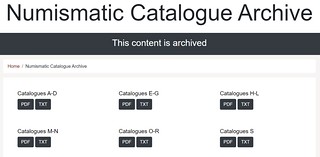 During the ANS Long Table Zoom call on July 8, which was hosted by ANS President Ute Wartenberg Kagan and featured Basil Demetriadi and his library, the discussion noted the bibliographic catalogs developed by Ted Buttrey (1929-2018) at the Fitzwilliam Library in Cambridge, UK. These catalogs enumerate no less than 55,000 auction sale catalogs and fixed price lists. These lists were updated through 2016 and surely represent the most complete such compilation. While the Gengerke bibliography (American Numismatic Auctions, 1990) listed 18,000 items, this was confined to sales containing American material.
During the ANS Long Table Zoom call on July 8, which was hosted by ANS President Ute Wartenberg Kagan and featured Basil Demetriadi and his library, the discussion noted the bibliographic catalogs developed by Ted Buttrey (1929-2018) at the Fitzwilliam Library in Cambridge, UK. These catalogs enumerate no less than 55,000 auction sale catalogs and fixed price lists. These lists were updated through 2016 and surely represent the most complete such compilation. While the Gengerke bibliography (American Numismatic Auctions, 1990) listed 18,000 items, this was confined to sales containing American material.
Buttrey's goal was to list everything, and, while gaps no doubt remain, these catalogs represent yet another legacy from this important numismatic scholar. As a test case, I looked up his entries on the Schulman series, which represents a tangled web spanning five generations. He dedicates 13 pages to the topic and includes a handy family tree that is useful in sorting out this complicated group of publications. The Buttrey lists are available in seven PDFs files that total about 1,300 pages. I lean digital and try not to print out things, but I'm considering making an exception in this case!
Is there a serious bibliophile out there willing to take over from Buttrey and bring this master list up to date? -Editor
Link to the Numismatic Catalogue Archive at the Fitzwilliam:
https://numismatic-catalogues.fitzmuseum.cam.ac.uk/catalogues/
Link to ANS Long Table archives:
https://numismatics.org/pocketchange-type/long-table/
NEWMAN PORTAL ADDS BILL RAU'S PATTERN DATABASE
Newman Numismatic Project Coordinator Len Augsburger passed along the following report from NNP intern Kellen Hoard on a massive database of U.S. pattern coin auction appearances, most from the pre-Internet era. -Editor
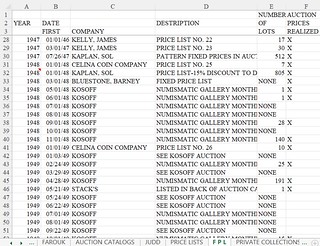 In the course of my internship work for the Newman Numismatic Portal this summer, I had the opportunity to work on, without a doubt, one of the most impressive numismatic projects I have encountered. Few other words are needed to describe it, both because the above description is complete and because readers ought to spend less time reading this update so that they might spend more time exploring it.
In the course of my internship work for the Newman Numismatic Portal this summer, I had the opportunity to work on, without a doubt, one of the most impressive numismatic projects I have encountered. Few other words are needed to describe it, both because the above description is complete and because readers ought to spend less time reading this update so that they might spend more time exploring it.
The project I speak of is Bill Rau's essentially complete dataset of prices realized at auction for U.S. patterns between 1851-2001. It is a genuinely staggering document to behold; over 70,000 lots are listed, with detailed information on each. Even for a non-collector such as myself, it is simply interesting to explore by virtue of its scale. The spreadsheet which contains this meticulously assembled information spanning centuries is available on the Newman Numismatic Portal at the link below, and contains 12 different tabs with varying data.
Tab 1 includes a general list of the patterns included in Pollock and Judd. The following information is provided for each pattern listed: Pollock number, Judd number, A-W number, Taxay number, Davis number, year struck, denomination, metal, Pollock rarity, Judd rarity, A-W rarity, and whether Bill Rau had personally owned an example at the time of this list's creation. Tabs 2-6 contain information on nearly every pattern sold at auction in a 150-year time period, with information on Pollock number, Judd number, year struck, denomination, metal, grade, Pollock rarity, winning bid, auctioneer, auction date, certification, lot number, and total price with buyers fee. Also included for many listings is the consignor (e.g. Benson Collection
).
Also notable are Tab 10, which contains information on over 10,000 lots of patterns sold via fixed price list from the late 1800s to 2001 and Tab 12, which contains an inventory of the Connecticut State Library pattern collection as of 1975.
No matter your collecting niche, take a moment (or many) out of your day to explore this document and appreciate the sheer effort it took to assemble such a valuable resource. Our hobby thrives and grows on research such as this, and it is important that we highlight such a monumental effort as a guide for what we all might hope to achieve within numismatics.
Newman Portal thanks Michael Bourne for his assistance with this content. Michael appreciated the significance of Rau's work and thankfully sought to make it available to a wider audience.
Link to Bill Rau patterns database on NNP:
https://nnp.wustl.edu/library/book/616032
VIDEO: STORY OF THE LA CAPITANA
These are selections from the David Lisot Video Library that feature news and personalities from the world of coin collecting. David has been attending coin conventions since 1972 and began videotaping in 1985. The Newman Numismatic Portal now lists all David's videos on their website at:
https://nnp.wustl.edu/library/multimediadetail/522852
Here's one on the treasure of the La Capitana. -Editor
Story of the La Capitana Shipwreck of 1654
Dave Horner
46:17
Dave is an author, diver, maritime historian. He was responsible for the discovery of the La Capitana shipwreck. When the ship was built it was the largest vessel ever in the Spanish flotilla and it had the treasure just as large!
David adds:
"I attended the Florida United Numismatists Coin Convention and was impressed with the amount of activity in the treasure coin and artifact market. Florida is where much of the treasure has been found and where the salvors and dealers go to trade. This video is one of the stories of the La Capitana
, Jesus de Limpia de Consolacion, a shipwreck off Chanduy, Ecuador. If you want a great numismatic experience with lots of business, buying and selling, educational seminars and camaraderie you might want to attend a FUN Convention!"
The video is available for viewing on NNP at:
https://archive.org/details/SEDWICK16003Story
MORE ON THOMASON'S SCIENTIFIC MEDALS
Judy Blackman writes:
"I thought you might like a little more info on the Scientific Medals, so I've attached the following article which was in the Nashua Coin Club newsletter last year."
Thank you. Here's an excerpt. -Editor
Edward was born around 1769 in Birmingham, England. His father Edward Thomason Senior (1740-1793) was a manufacturer of buckles for over forty years, and his mother was Mary Garlick. During this period, shoe-buckles were worn by all classes of society, and Senior Thomason's manufactory produced as many as a thousand pairs of buckles daily.
Edward Junior began manufacturing in his father's factory around 1793, establishing a trade in gilt and plated buttons. The business expanded to manufacture medals, snuff boxes, watch cases, vases, sculptures, tokens and coins, and later plated gold and silver works. Later, at age 66, in 1835, Junior sold the business to Whitegrave and Collis.
At the age of sixteen Thomason was articled in the foundry to the famed Matthew Boulton of Soho. He was a student-in-residence of Boulton's from ages 16-21. As his own memoirs confirm, the extent of Boutlon's manufactory and the diversified machinery used for the furtherance of the manufacture of the numerous and varied articles made on his premises, excelled all others of a like description in Europe. This scientific school produced in Thomason a versatility of taste for mechanism, and a turn for art and science. On the other hand, it seems to have given him an ambitious feeling, far beyond the means he possessed on coming of age to indulge in. When 21 years of age, he began to manufacture on his own account; first establishing the trade of gilt and silver buttons, of the finest class; he then added to it the trade of gilt and gold jewellery; to those was annexed a department for the making of medals, tokens, wine coolers, soup tureens, serving trays, candlelabras, salt cellars, horseshoes, shields, and coins, of gold, silver bronze etc., as well as works in bronze, and fine cut glass, etc. Lastly, he subjoined a manufactory for silver and gold plate, and silver-mounted plated wares of the highest class of workmanship. These trades occupied sixty or seventy rooms, including several devoted to exhibition.
His list of registered patents under his name for his many inventions and manufacturing processes is far too long to include here. Edward Junior was a diligent inventor. For example, in 1839 he improved the gun lock by making the cock detachable by the thumb and finger as well as making improvements to prevent misfires. He's very well known for his corkscrew invention.
But the line of business in which Thomason was specially engaged for forty years, was confined to the highest class in the metallic arts. In 1830 he completed the laborious work of sixty large medals on the Bible (a commemorative replica set was later issued by the Franklin Mint, which I added to my Thomason collection); in which the most prominent events in Sacred History are concisely told. The origin of these medals arose from the visit to Birmingham of a gentleman connected with the Austrian Court, and who hitherto had never heard of Birmingham. Thomason was forcibly struck with this circumstance, and determined to endeavour to make the town known to all Monarchs and Courts in the civilized world; - hence the manufacture of these medals at a great cost, which were forwarded to all the Sovereigns of Europe.
The language used here, is the language Thomason used in his memoirs describing his life. In 1844, Edward Junior retired from business and moved to Ludlow, then Bath, then Warwick where he focused on trying to complete his memoirs. [Sir Edward Thomason's Memoirs during Half a Century was published in 1845 by Longman, Brown, Green, and Longmans, London, although unfinished due to Thomason's failing health, so the later years were assisted by many others. These memoirs illustrate his manufactured products and inventions, along with his high quality metallic art medals.]
From a Canadian history perspective, we have a coin originating from Thomason's factory. After the American revolution the Magdalen Islands were granted to Sir Isaac Coffin, who only once visited his American possessions; this was in 1815. Before starting he ordered a large number of these coins and a coining press from Sir Edward Thomason, of Birmingham. These he brought to the Islands and distributed the coins by way of loans among the chief men in the Islands. It was his purpose to set up a mint and coin half-pennies as well, but no other coin than the above was ever issued. This one was in the Heritage Auctions catalogue #1100 in 2008.
Another American medal sourced from Thomason's, is the 1826 Erie Canal Completion Medal in White Medal, 81mm, 185.1gm (similar but not identical to design HK-1, but much larger). Obverse: Pan with cornucopia and Neptune with trident in center, lighthouse and sea, legend around UNION OF ERIE WITH THE ATLANTIC, and reverse New York state coat of arms, section of canal, sailing ship and view of city in distance, EXCELSIOR on scroll, legend around ERIE CANAL COMMENCED 4 JULY 1817 26 OCTBr. 1825., microscopic THOMASON at lower rim.
I wasn't aware of Thomason's connection to the Magdalen Islands token and Erie Canal Completion Medal. -Editor
To read the earlier E-Sylum article, see:
SIR EDWARD THOMASON'S SCIENTIFIC MEDALS
(https://www.coinbooks.org/v25/esylum_v25n27a28.html)
NOTES FROM E-SYLUM READERS: JULY 10, 2022
Federal Reserve Bank Bags
Phil Iversen writes:
"After reading the article by David Lange on bank bags I was finally able to locate two from my small collection and was wondering if anybody has ever put together a complete set of bags from all of the 12 Federal Reserve Districts?"
Great question - that would probably be some accomplishment. Anyone? -Editor
To read the earlier E-Sylum articles, see:
U. S. MINT CANVAS BAGS
(https://www.coinbooks.org/v25/esylum_v25n26a11.html)
NOTES FROM E-SYLUM READERS: JULY 3, 2022 : 1938 Nickel Mint Bags
(https://www.coinbooks.org/v25/esylum_v25n27a12.html)
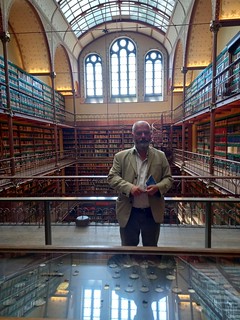 More on the Rijksmuseum Coin Exhibit
More on the Rijksmuseum Coin Exhibit
David Pickup writes:
"I was reading Patrick's article about the Rijksmuseum coin display, coincidentally I was there as well a couple of weeks ago."
Thanks. David provided a photo for us. A beautiful space! -Editor
Regarding the 1794 dollar displayed there, Bill Eckberg writes:
"I saw that piece as well a few years ago. I was very surprised to find it, and I dragged my wife away from all of the Rembrandts, Vermeers, etc. on the wall to see it.
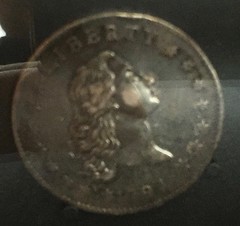 "She was not as excited by it as I was. I took a terrible picture through an unfortunately very reflective glass, but you can tell what it is. To my eye, it looked XF or maybe better.
As a relatively high grade piece, I suspect that it may have been a diplomatic gift, since the Netherlands was the first - or one of the first - countries to recognize American Independence."
"She was not as excited by it as I was. I took a terrible picture through an unfortunately very reflective glass, but you can tell what it is. To my eye, it looked XF or maybe better.
As a relatively high grade piece, I suspect that it may have been a diplomatic gift, since the Netherlands was the first - or one of the first - countries to recognize American Independence."
To read the earlier E-Sylum article, see:
RIJKSMUSEUM LIBRARY NUMISMATIC EXHIBIT
(https://www.coinbooks.org/v25/esylum_v25n27a19.html)
A Coin-Roll-Dispensing ATM
Last week I asked if the coin-roll-dispensing ATMs in Australia had counterparts here in the U.S.
B.J. Herbison writes:
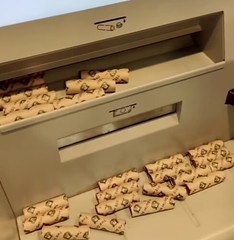 "I ran into an ATM for businesses that dispensed coin rolls in Worcester,
Massachusetts a couple of decades ago. It was in a public area on the
outside of the bank, but not near the standard retail ATMs.
"I ran into an ATM for businesses that dispensed coin rolls in Worcester,
Massachusetts a couple of decades ago. It was in a public area on the
outside of the bank, but not near the standard retail ATMs.
"I don't remember the name of the bank, and the mall it was in has been torn down for several years. In the center of a city they needed to charge for parking so the garage wouldn't fill with the cars of commuters so it couldn't compete with suburban malls with free parking."
Thanks - it makes sense as a business service. The article we excerpted discussed "coin noodling" - searching through coin rolls for pieces worth more than face value. -Editor
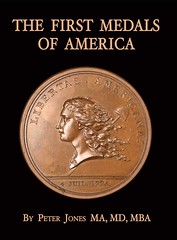 Query: Print-on-Demand Sewn Bindings
Query: Print-on-Demand Sewn Bindings
Author Peter Jones writes:
"I have been using BookBaby to print my books as they are reasonable and do print on demand, and fulfill orders for me. However, they only do perfect binding. Do you know of any similar printers who do sewn signatures?"
Good question. I don't know - can anyone help? -Editor
Yale Numismatics Department Seeks Assistant Curator
The Yale University Art Gallery Numismatics Department is seeking an assistant curator. -Editor
"This is an exciting opportunity and we're delighted to be able to have a second curator join the department team."
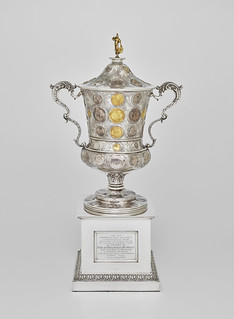 The Yale numismatics collection is the largest American university collection and a growing resource for teaching across the University. The Bela Lyon Pratt Study Room for Numismatics, established in 2012, comprises of a coin room and library, as well as an adjacent object study classroom that is used for teaching with the collection by faculty and curators. The Numismatics department also opened a newly renovated permanent collection gallery (opened May 2022) and exponential collection growth in multiple areas is expected in the future.
The Yale numismatics collection is the largest American university collection and a growing resource for teaching across the University. The Bela Lyon Pratt Study Room for Numismatics, established in 2012, comprises of a coin room and library, as well as an adjacent object study classroom that is used for teaching with the collection by faculty and curators. The Numismatics department also opened a newly renovated permanent collection gallery (opened May 2022) and exponential collection growth in multiple areas is expected in the future.
The Yale University Art Gallery seeks a dynamic, knowledgeable, and collegial assistant curator for the Department of Numismatics. Reporting to the Jackson-Tomasko Associate Curator of Numismatics, the successful candidate will have an interest in the connoisseurship of coins viewed as works of art and in the long recognized use of coins as evidence for understanding social and cultural history. Knowledge of numismatics across time and cultures is required. The candidate is expected to be or to become a recognized expert in Greek and Hellenistic numismatics, through study, research, publication, and exhibitions.
The successful candidate will demonstrate a collegial spirit, a strong commitment to collection development, and to mentoring students. It is also expected that they have a strong grasp of digital approaches to numismatics and are able to specify in what ways their specialization(s) will complement and enrich the department. The new assistant curator must able to prioritize daily tasks and long-term objectives for the benefit of the department, and will be expected to work on parts of the collection outside their area(s) of expertise.
For more information, or to apply, see:
Damsky Assistant Curator of Numismatics
To read earlier E-Sylum articles, see:
YALE'S BELA LYON PRATT GALLERY OF NUMISMATICS
(https://www.coinbooks.org/v25/esylum_v25n22a11.html)
PRATT GALLERY SHOWCASES MONEY AND MEDALS
(https://www.coinbooks.org/v25/esylum_v25n27a18.html)
Catfish Noodling
John Phipps writes:
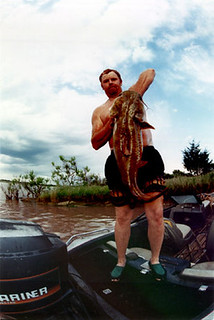 "Interesting item on "coin noodling" in last week's E-Sylum. 'Noodling' is what drew my attention. Where I grew up (Kansas and Missouri), noodling was catching catfish with your hands. I believe that more people talk about catfish noodling than actually do it. For catfish noodling, you look for a place in the riverbank that catfish like to hide in. Then you reach into a catfish's mouth. The catfish bites down on your wrist or arm and you pull the fish out of the water. For the noodler, this technique is very muddy, usually involves loss of blood and can be dangerous. I have never noodled but have watched other do it."
"Interesting item on "coin noodling" in last week's E-Sylum. 'Noodling' is what drew my attention. Where I grew up (Kansas and Missouri), noodling was catching catfish with your hands. I believe that more people talk about catfish noodling than actually do it. For catfish noodling, you look for a place in the riverbank that catfish like to hide in. Then you reach into a catfish's mouth. The catfish bites down on your wrist or arm and you pull the fish out of the water. For the noodler, this technique is very muddy, usually involves loss of blood and can be dangerous. I have never noodled but have watched other do it."
Interesting - I hadn't heard of that. There's even a Wikipedia page for it and an Animal Planet "Hillbilly Handfishing" episode.
There have been the occasional fisticuffs at auctions and new coin release lines, but loss of blood is rare in the numismatic world. -Editor
For the Wikipedia article, see:
https://en.wikipedia.org/wiki/Noodling
To read the earlier E-Sylum article, see:
AUSTRALIAN COIN NOODLING
(https://www.coinbooks.org/v25/esylum_v25n27a36.html)
The Franklin Mint's Medallic History of the United States Set Available
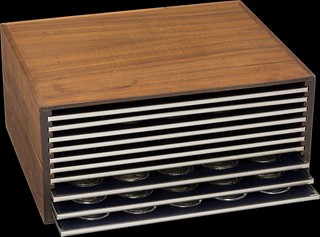 My old friend Sam Deep writes:
My old friend Sam Deep writes:
"In the July 3 issue, the Franklin Mint 200 years of U.S. History Set came up. If anyone's seeking an available set, I'm looking to sell one I bought many years ago. Just had my 80th birthday and so am looking to save my family from having to sell the remnants of my collection."
I'll be happy to put anyone interested in touch with Sam. -Editor
To read the earlier E-Sylum article, see:
FRANKLIN MINT'S MEDALLIC HISTORY OF THE U.S.
(https://www.coinbooks.org/v25/esylum_v25n27a07.html)
An Encased Postage Locket
Vic Agha writes:
"I've got something I'd like to show off. I keep an eye out for unique and unusual numismatic items and recently came across this. Coins being refashioned into lockets are uncommon but I'd like to say that this one takes the cake.
"On a related note, if anybody ever messes with an encased postage stamp, you'll know it because of the pry marks."
Thanks. Can't say I've ever seen something like this - someone cracked the stamp out of an encasement and replaced it with a photo to make a locket.
However, it is possible to open one of the cases without inflicting so much obvious damage. Not a foolproof method, but a better one. If you heat the casing it will be easier to gently pry the piece open, and using the same techinique, the piece can be closed again with much less obvious damage. Not foolproof as I said, but you have to look close. All high-denomination encased postage stamps should be examined carefully for signs of tampering. Perhaps unsurprisingly, I learned this from John J. Ford, Jr. -Editor
It says so right on the coin!
Pablo Hoffman passed along this story from The New York Times. Thanks! -Editor
I had gotten off the F at Borough Hall on my way to my job at New York City College of Technology. I passed two young men on the platform who appeared to be students.
They warn you right up front,
one said to the other. Look, it's on the coin. See: ‘E pluribus unum.' Let the buyer beware.
I was never any good at reading Greek.... -Editor
COIN DESIGNS CELEBRATING FREEDOM
I have a hefty supply of email and realized this week that I hadn't published this note from Wayne Pearson on ideas for coin designs celebrating Freedom. Sorry for the delay - happy 10th of July, everyone. -Editor
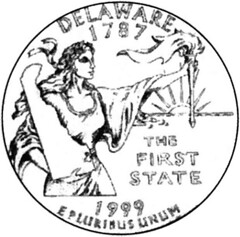 After 246 years, are we a free people? Does the constitution still have meaning?
After 246 years, are we a free people? Does the constitution still have meaning?
If our coins were to represent us here are a couple of concepts that might be on them. First up are two half dollars, using a smaller, heptagon shape, so vending machines can accept them, showing our liberty to vote. This design is based on a pattern design for a Delaware state quarter.
Next is a dollar coin idea based on the Libertas Americana design and one of the drawings.
Check out the article elsewhere in this issue on the Presidential Medal of Freedom. -Editor
REFERENCES
https://www.metmuseum.org/art/collection/search/190496
https://www.metmuseum.org/art/collection/search/190496
https://www.peterharringtongallery.co.uk/blog/libertas-americana/
VOCABULARY TERM: KEYNOTE, KEYSTONE
Here's another entry from Dick Johnson's Encyclopedia of Coin and Medal Terminology. I added the medal image. -Editor
Keynote, Keystone. A medal associated with a series but with a feature different from all others in the series. The medal usually symbolizes the entire series and is most often struck first, or is presented with the entire purchase of the series. A Yellowstone Medal was a keystone medal for a National Park Centennial Series, 1972; or a Treasury Seal Medal with the 11-medal set of America's First Medals, 1976. The Medical Heritage Society Series issued by Franklin Mint included an Aesculapius Medal, 1969, as separate but similar item to the series. For their Apollo Flight Series Franklin Mint called the initial medal a keynote medal, as they did for a 1972 medal at the beginning of issuing the Great Olympic Moments Series. In France such a medal is called pre-series.
A keynote or keystone medal is usually issued before a series is started or shortly thereafter. An encore medal is issued after the series is completed, as if the collectors of the series are asking for a repeat performance, or another item to add to the series. Such keynote, keystone or encore medals may be larger or smaller or not even share the same specifications as other medals in the series. It must, however, bear the same theme as the series.
In cataloging, the keystone or keynote medal is usually designated "A" while those in the series are numbered consecutively in the order of their issue. An encore medal may or may not be numbered with the series.
To read the complete entry on the Newman Numismatic Portal, see:
Keynote, Keystone
(https://nnp.wustl.edu/library/dictionarydetail/516191)
THE SOMMERS ISLAND FRAUD
Mike Costanzo submitted this article about the fantasy Sommers Island gold pound. Illustrated is a modern example struck from dies originally created by Wuesthoff in the early 1880's. -Editor
From 1979 to 1981, Bowers & Ruddy Galleries sold the outstanding collection of
T. Harrison Garrett in four highly celebrated auctions. Among the 2,453 lots was a
highly questionable purchase made by Garrett in 1884 from dealer and future
author Lyman H. Low. The coin in question was a Sommers Island twenty
shilling gold piece.
On October 24, 1884, Lyman Low wrote to Garrett offering him the greatest
rarity and choicest gem which has ever come into my hands,
a unique Sommers
Island twenty shilling gold piece. Low theorized that a number of them were
struck off, but proving useless, they probably found their way to the melting pot.
Despite the piece appearing questionable to typical Sommers Island coinage, Low
considered it genuine and concluded I bought it on my judgment and sell it on my
reputation.
On October 29th, Low followed up with yet another letter concerning the piece
and claiming it arrived from Germany with a lack of numismatic intelligence on
the part of the owner
as to its real value. Low added that he could add no
additional details regarding its history but put its value it in the class of the Brasher
Doubloon and Good Samaritan shilling. Garrett took the bait and two days later
Low acknowledged Garrett's check of $500 for the piece.
The Sommers Island gold piece remained in Garrett's collection well after Garrett's death in 1888 and continued to reside among later additions made by Garrett's sons, Robert and John Work. The John Hopkins University would later inherit the collection and eventually put the contents up for auction.
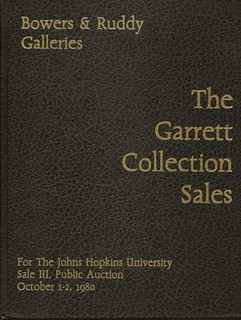 The third of these four public auctions by Bowers & Ruddy took place on
October 1-2, 1980, with lot number 1199 listed as the
The third of these four public auctions by Bowers & Ruddy took place on
October 1-2, 1980, with lot number 1199 listed as the Sommer Islands Gold
pound.
Like the 1795 North Wales Halfpenny and 1781 North American Token,
the Sommers Island piece exhibited artificial wear produced from unfinished dies.
Bowers & Ruddy offered the piece as an interesting piece de caprice which
played a brief but dramatic role in 19th-century American numismatic history.
It sold for a high bid of $1250.
Bowers & Ruddy listed the piece as a fantasy or fabrication,
adding
it was manufactured during the 1880's by a New York dealer known as only as
Wuesthoff.
Although the piece fooled Garret, whether it also fooled Low is
another question. At the time (1884) Low had only been a dealer for a year, and his
published reference of Hard Times tokens was still two years off. In The History of
United States Coinage as Illustrated by the Garrett Collection, author Q. David Bowers summed up the transaction by diplomatically noting, Whether or not Low
was aware of the deception is not known today.
The Sommer Island Gold Pound as it appeared in the Bowers & Ruddy auction
listing.
Low, however, appeared to be pushing the piece on Garrett by writing two letters
in five days extolling the rarity of the coin, before successfully closing the sale
within the span of a week. Low also failed to mention the fact that the piece was
previously mentioned in Edouard Frossard's Numisma, which led an editor of The
American Journal of Numismatics to question the authenticity of the piece in print.
Frossard followed up by writing in the July 1884 issue of Numisma If the XX
shilling can be proved bogus it is a worthless token, of no more value, except in
metal, than the well-known restrikes of the Hog Island shilling. If authentic, it is
one of the rarest and one of the most interesting numismatic monuments relating to
the early days of America.
Had Garrett subscribed to Numisma he would have been aware of the notoriety
of the piece well before being offered it by Low. At the same time, Frossard's
comments pertaining to the possibility of the coin's historical significance may
have only whetted his appetite. Bower & Ruddy's auction catalog also makes note
of this observation, stating Whether or not Garrett was aware of the controversy
from his own independent reading of numismatic literature cannot be determined.
Garrett could have also made use of one of the best reference publications available in his day, namely Sylvester Crosby's Early Coins of America. Crosby's 1875 book covered the Sommer Island issues as well as included photographed specimens in Plate I of the book. Included in this very plate were photos of authentic issues as well as modern day copies.
As for the $500 Garrett paid for this fabrication, it should be noted that Garrett had purchased a genuine 1804 silver dollar from dealer George Cogan a year earlier for $765. It should also be noted that the modern-day purchasing power of $500 in 1884 amounts to over $14,000 in 2022. Garrett would continue to conduct other business with Low, but the Sommer Island piece was apparently never discussed again.
As for the Sommer Island gold pound, it has not surfaced since 1980 and its whereabouts remain unknown. Bowers & Ruddy's listing also noted the dies for the fabrication surfaced in the late 1950's and were purchased by a Pittsburgh dealer, who then struck off additional pieces. Luckily, Robert Bashlow never got his hands on them.
The Garrett sales were a high benchmark in the rare coin market at the time, with many pieces exceeding their pre-sale auction estimate, and the twenty-shilling gold pound was no exception. $1,250 was a lot to pay for a known fantasy, and still is. And the disturbing fact remains that additional copies had been struck off when the Garrett piece was purchased mainly for its pedigree. This complicates matters for the high bidder whomever they were, much less whomever holds the piece today.
Caveat emptor.
Sources:
The History of United States Coinage as Illustrated by the Garrett Collection. Q.
David Bowers. (Bower & Ruddy Galleries, 1979)
The Garrett Collection Sales. Sale III, October 1-2, 1980. (Bower & Ruddy
Galleries,1980)
Numisma. (Frossard) Vol 7, Number 6. November 1883.
Numisma. (Frossard) Vol 8, Number 4. July 1884.
The Early Coins of America. Sylvester S. Crosby (Token and Medal Society,
1965)
HARVEY STACK'S NUMISMATIC FAMILY, PART 125
Stack's Bowers has a backlog of the late Harvey Stack's numismatic memoir articles and will continue publishing them. In this one Harvey discusses the year 1998, which opened with the signing of the Statehood Commemorative Quarter Dollar Coinage Act, some important museum collection sales and a Reed Hawn sale in May. See the article elsewhere in this issue about collector Hawn, who recently passed away. -Editor
1998 started off with a great numismatic surprise! In late December of 1997 Congress passed into law the Statehood Commemorative Quarter Dollar Coinage Act, and during the first week of January 1998 President Bill Clinton signed the law authorizing the new issues. This act provided for the Mint to each year issue five individual quarters for general circulation, commemorating each state's entering the Union. These quarters would be issued in the order that the states joined the United States, starting with Delaware and, in the first year, including Pennsylvania, New Jersey, Georgia and Connecticut. The series would run for 10 years and result in a set of 50 state quarters. This followed the idea I had presented before the Banking and Finance Committee of Congress in 1995, and I was indeed honored that the idea was adopted. Over the next decade these quarters would be struck by the billions and offered a way for people to once again collect coins
from their daily change at just the cost of the coins' face value.
In 1998 Stack's was in contact with several museums that were desirous of selling some of their numismatic duplicates in order to redo their exhibits and make their displays more attractive and informative. We were able to offer through our auctions a great selection of scarce and hard to find numismatic items. From these various institutions together with some privately owned collections we produced seven important auction catalogs, which collectively contained about 13,000 lots of United States, Foreign and Ancient coins in all metals. As a result of these public auctions and our over-the-counter dealings 1998 was a very productive year for us. Many collectors and dealers whom we had not seen for several years visited with us and enlivened our sales.
January featured a 1,682-lot catalog of colonial and federal coins, medals and currency, highlighted by many choice and classic numismatic items. Our March event started with a collection of Confederate notes from the Museum of Connecticut History, along with a highly pedigreed collection of late date United States large cents. The Cherry Creek Collection added rare and unusual U.S. gold coins to the sale, resulting in over 2,000 lots of important material.
In May we were very pleased to feature the outstanding collection of early Massachusetts silver formed by Reed Hawn, a noted numismatist from Texas. This sale of 1,341 lots included many very desirable items. June brought our sale of a large and important collection of world coins and paper money from Wesley A. Miller and Dr. Alfred R. Globus, as well as the Museum of Connecticut History. This catalog of nearly 2,200 lots featured pieces that were rarely offered at public auction.
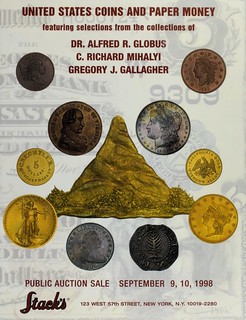 Our fall season opened with our September sale that once again featured the Dr. Alfred R. Globus Collection, as well as a classic collection of early European coins from Richard Mahaly and a wonderful selection of world coinage from Gregory J. Gallagher. This sale of 1,975 lots was a highlight world coin sale of the year and attracted a huge audience of bidders and also brought in a large number of mail bid sheets. In October we celebrated our 63rd year of auctions with a catalog of 1,776 lots of rare and choice United States gold and silver coins, primarily from the estate of Carl Zelson.
Our fall season opened with our September sale that once again featured the Dr. Alfred R. Globus Collection, as well as a classic collection of early European coins from Richard Mahaly and a wonderful selection of world coinage from Gregory J. Gallagher. This sale of 1,975 lots was a highlight world coin sale of the year and attracted a huge audience of bidders and also brought in a large number of mail bid sheets. In October we celebrated our 63rd year of auctions with a catalog of 1,776 lots of rare and choice United States gold and silver coins, primarily from the estate of Carl Zelson.
This collection, which had been almost 40 years in the making, featured many exceptional early coins that had been purchased from collections that had been built in the 1950s and early 1960s. Our auction year closed out in December with a sale that offered something for everyone as it featured ancient, foreign and U.S. coins that had been assembled by the two major consignors over decades of searching. It was a great sale to end a great year of auctions for Stack's and we looked forward to another successful year in 1999.
To read the complete article, see:
GROWING UP IN A NUMISMATIC FAMILY, PART 125
(https://stacksbowers.com/growing-up-in-a-numismatic-family-part-125/)
To read the earlier E-Sylum article, see:
HARVEY STACK'S NUMISMATIC FAMILY, PART 124
(https://www.coinbooks.org/v25/esylum_v25n26a15.html)
FRED WEINBERG INTERVIEW, PART ONE
Published in two parts across two different ErrorScope issues earlier this year, Greg Bennick's interview with dealer and longtime E-Sylum supporter Fred Weinberg is a wonderful look at the hobby and business of error coin collecting over the last half century. With permission from the Combined Organization of Numismatic Error Collectors of America (CONECA), we're republishing it in four parts over as many weeks. Here's part one, where Fred discusses how he got started dealing in errors. -Editor
Fred Weinberg Interview
By Greg Bennick
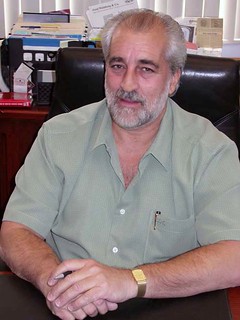 For anyone who has collected error coins in the last half century, Fred Weinberg is both a familiar name
and an inspiration. In 2021 when he announced his retirement, I knew that a comprehensive interview for
ErrorScope would be a great way for the magazine to wrap up his career, especially since he did so much for
the publication in its early days. This interview was conducted in February 2022 by phone and it has been an
honor to put it together for the magazine!
For anyone who has collected error coins in the last half century, Fred Weinberg is both a familiar name
and an inspiration. In 2021 when he announced his retirement, I knew that a comprehensive interview for
ErrorScope would be a great way for the magazine to wrap up his career, especially since he did so much for
the publication in its early days. This interview was conducted in February 2022 by phone and it has been an
honor to put it together for the magazine!
Greg Bennick: So, tell me: why errors? With all the things out there to collect, what's the allure of errors to you as a specialty? What's fascinated you most about them?
Fred Weinberg: When I started out collecting, as a Cub Scout, I did both stamps and coins. I always thought
coins were cooler. When I was 10 or 11 years old, I started finding odd things on coins like a lot of people do.
Things that just looked different. I would examine them with a magnifying glass and try to figure out what they
were. Was it a lamination, was it a die crack, was it a scratch…what was it? I was already a subscriber to Coin
World, and one of the first things I did every week when I got Coin World in the mail was to turn to the very last
page to the Collector's Clearinghouse
, which often ran photographs of error coins that people would send in
to James Johnson and Marilyn Tiernan, who were running Collector's Clearinghouse at the time. And just to
see pictures in black and white of an off center penny or a double struck anything was just incredibly exciting
for me. At the time, I really couldn't travel to too many coin shops unless my parents took me. I just found
errors myself and thought they were fascinating because they were so different.
Also, at that time I was starting to read about parapsychology and ESP and strange things, and I just thought errors were kind of like the flying saucers, or the ESP subject, of numismatics. So that always interested me also. I learned over a period of years about the minting process, and especially so when I started going to the Error Club of Hollywood meetings in 1967, which was about six or seven years after I started collecting.
Greg Bennick: What was it about coins that attracted you?
Fred Weinberg: Stamps just didn't really excite me although they were colorful. I thought coins had more heft. They were made out of metal, and they weighed something. And more importantly I had access to them. I had a paper route, like a lot of kids did in the 60s, and I would collect 25 cents a month at the end of the month from at least a few hundred people to whom I'd delivered the local newspaper. I'd come home and just dump out all these coins on my little desk in my room and start to go through them.
Maybe I would pull out a silver coin, or a lot of times there was a foreign coin that somebody tried to slip in. Interestingly enough, one of the things that really got me motivated was the time I came home one night, this would have been in the winter, around 1962 or 1963 at the latest and had that big pile of coins on my desk and there was an 1882 $10 gold piece that somebody had given me. They probably gave it to me as a foreign coin. I found that when I collected and it was dark outside, I got more foreign coins than when I collected the change in the summertime and it was lighter outside. People either on purpose or by accident would give me those foreign coins.
So, someone had given me an 1882 $10 gold piece. There was no way I could return it because I had no idea who amongst the few hundred people might have given it to me. That was likely the first time I ever held and touched a gold coin.
A couple of years later when the 1964 Kennedy Proof Sets came out, they were issued for $2.10 each by the US Mint. And they immediately went up to about $20 or $22 per set because of Kennedy's popularity, and also the fact that the mint had announced that they weren't going to make any more silver coins. In my first bad trade deal that I can remember, I went into my local coin shop and I traded that 1882 $10 gold piece straight across for a 1964 Kennedy Proof Set. The Proof Set today is worth $20 or so, and the gold coin's worth probably $900 or $950. So, I tell people, keep the gold, don't buy modern issues (laughs).
Greg Bennick: That's amazing! And it leads into my next question. I'm curious about your first error coin. Is it true that the first error coin you bought was a fake, as I read in a very early issue of ErrorScope?
Fred Weinberg: Yes, that's true. There was a coin store on Fairfax Boulevard in Los Angeles. My mother took me there one day, and I said I was interested in errors. He had a 1941 nickel that was impressed on the reverse, backwards of course, with a penny. It was a 1940 or 1950 something penny. I was about 10 years old, maybe 11, and I bought that coin for about $4. It took me about a year and a half or so to figure out that it was what I call a sandwich coin. Somebody just pressed another coin into the nickel. I've always thought over the decades that dealer -- who I didn't see for many years after that -- knew what it was and didn't care. Because it was pretty obvious what it was once I started learning about the minting process. I was very lucky, because I got to learn the minting process from some of the great people in the error hobby from the 1950's and 60's.
Greg Bennick: Given that you got burned on your first error coin purchase (and I know that's happened to me certainly as well over the years) was that experience discouraging? What errors got you motivated?
Fred Weinberg: Well, I wouldn't say that I was discouraged. I was probably a little more upset with myself that I got taken in. But I let it slide. As far as what errors motivated me, that's tough, because before the first Error- A-Rama, which was held in Hollywood in June of 1967, my only access to errors would have either been a local coin shop - I wasn't even old enough to go to the Long Beach coin show at that point - or reading Collector's Clearinghouse in Coin World, or the page or two about errors which would appear from time to time in CoinAge magazine, or something like that. I really wasn't exposed to actual coins, aside from photographs of errors, until I started going to the local club meetings in 1967.
Greg Bennick: What were the local club meetings like? You must have been the youngest person there!
Fred Weinberg: In 1967, I had just turned 17 and believe it or not, I wasn't the youngest! I was among the youngest, but the Wallaces who I met for the first time at the Error Club of Hollywood, and then of course saw them at the Orange County Error Club, were younger than me. Donnie, Debbie, and Susan. There were two sisters and a brother, and Don and Evelyne Wallace were their parents. They owned the Wallace Trade Bindery who ended up publishing ErrorScope for many, many years. So, I was among the youngest, but I wasn't quite the youngest. At the time, there were probably, oh I would say, a half a dozen high school-ish, and maybe even college kids going to those meetings. But most of the meetings were attended by adults from West Los Angeles, Hollywood, you know, the general southern California area.
Greg Bennick: And this was an actual error specific club in Hollywood?
Fred Weinberg: Yeah, Mort Goodman started it with a guy named Si Kaufman from Culver City. It was after the first Error-A-Rama that was put on at the Hollywood Roosevelt Hotel on Hollywood Boulevard. Because of the success of the Error-A-Rama, they'd started the Error Club of Hollywood.
So it was quite exciting to every month drive up to Hollywood and there would be 30 or 40, mostly adults, sitting in the audience and we'd talk and they'd have lottery games and a presentation and a little trading, and it was wonderful. I learned a lot about the minting process from some of the experts like Mort Goodman. Syd Kass would come down on a rare occasion from Stockton. And right now I'm probably one of the few people alive that remembers meeting and spending time with Blakesley, who of course is very famous for his Blakesley effect on clipped planchets of all different types. He was a very interesting person.
For more information about CONECA, see:
https://conecaonline.org/
MORE ROSA AMERICANA PRICE LIST #23 SELECTIONS
Here are a few more items that caught my eye in Jeff Rock's Rosa Americana Colonial Coins fixed price list #23. To get your copy, contact Jeff at rosaamltd@gmail.com. -Editor
1766 Pitt Halfpenny
10. 1766 Pitt Halfpenny. Betts 519, W-8350. Very Fine, well struck save for the extreme right edge of the reverse, an area that is often seen weak on this type; this causes a loss of the legend there, the remainder of the letters on either side mostly strong. The bust of Pitt and the ship are both sharp and show solid VF design detail. Nice medium brown, the surfaces hard and pleasing to the eye. A fascinating issue, one that is clearly important to the American colonial collector as the design not only names America on the reverse, but refers to the infamous Stamp Act which both propelled Pitt into prominence and, a decade later, the American colonies into revolution. Collectors of this historic issue are often faced with just two choices: paying a lot of money for an AU or Uncirculated specimen or finding a more affordable circulated one that is rough or damaged – this is the rare exception that is circulated, not damaged, quite pleasing in color and overall eye appeal, yet still quite affordable.......... $900
A nice pleasing example. -Editor
1787 Connecticut Copper
25. 1787 Connecticut Copper. Miller 18-g.1. Rarity-6. Choice About Uncirculated. This is the STEVE TANNENBAUM specimen of the variety and appeared as Lot 7173 in the Stack's Bowers sale of his collection in January, 2012, where it was described as follows:
1787 Connecticut Copper. Miller 18-g.1, W-3045. Rarity-6. Draped Bust Facing Left. EF-45. 130.1 grains. Deep golden brown with traces of red in the protected areas though no doubt from a long-ago cleaning. Sharpness easily equal to the task of the assigned grade and readily comparable to Perkins:290 and Ford:313. Usual swelling in left obverse field, some central ticks from the striking process at the center and a light natural fissure along the hair ribbon, reverse with numerous tiny central ticks as well. Nicely centered and highly attractive, and perhaps at the low end of the Condition Census for the variety.
We disagree slightly with the cataloguer of that sale in terms of grade – to our eyes the light red in the protected areas is completely natural, and the coin is a full AU in grade; bidders in the audience certainly agreed, as the piece realized $1,150 over a half dozen years ago, which was fair AU money at the time. Steve considered it to be the second finest known of the variety, and indeed we have not seen anything better than this at auction; the closest was the Partrick- Hessberg coin, an AU with a large planchet flaw. Ford's was a Choice VF but still called the second finest seen by its cataloguer – though this example is much nicer in every respect. This is one of a handful of Connecticut Copper varieties that proved to be much rarer than previously thought, and its rarity rating has gone up over the years while most others have drifted at least slightly downwards. This example has the typical late obverse die state, the swelling no doubt accounting for the rarity of the variety today. This obverse was paired only with this reverse, so it seems both dies must have failed around the same time. A gorgeous example of a legitimately rare variety, with an exceptional provenance. This will simply not be improved upon.......$2,250
Accompanied by Steve's original handwritten envelope and the lot ticket from the auction of his collection.
Nice piece! -Editor
1787 Connecticut Snipe Nose
Copper
28. 1787 Connecticut Copper. Miller 33.28-Z.16, W-3770, the Snipe Nose
obverse. High
Rarity-4. Choice Extremely Fine, a boldly struck example of this very scarce and popular
variety. The legends are full, the individual letters all strong, as are the digits in the date which
is, unusually, completely on the planchet. The obverse bust shows all the fine detail in the
drapery, significant hair design and a prominent eye, while the reverse figure shows most of the
folds in her dress and a strong globe, shield and branch – even the centers of the cinquefoils on
either side show the intricate design detail at their centers which quickly gets worn away. Dark
olive brown, the surfaces with the faintest roughness, but with significant eye appeal – especially
since there are no major marks or damage from circulation.
Usual late obverse state with a
horizontal diebreak nearly bisecting the die and extending out under the bust's nose, giving the
nickname for this variety.
Robert Martin had a pair of marginally sharper AUs that brought $4,200 and $6,300 in a very weak market, and Partrick's somewhat flawed AU brought $5,280 – compare the detail and this one is right up there, but a heck of a lot lower in price. A great find for the collector, with a wonderful provenance too..........$1.050
Super coin with a great provenance. -Editor
To read the earlier E-Sylum article, see:
ROSA AMERICANA FIXED PRICE LIST #23 SELECTIONS
(https://www.coinbooks.org/v25/esylum_v25n27a23.html)
HOLABIRD JULY 2022 SALE SELECTIONS
Here are some lots that caught my eye in the upcoming Holabird sale. -Editor
Foraker, OK - $10 1902 Plain Back Fr. 629 The First NB Ch. # 10356. An exceptionally rare note with two of the three reported notes are listed in the census without grades, having been off the market for so long that their grades are unknown. Last Known note to sell in public auction in 2010 was a "NET" Fine for $1,600.00. This Note is a Solid VF with wonderful embossing and color. Miniscule pin hole above cashier signature. Does not detract. Who knows when another will appear or be as nice?
A rare note in great condition. -Editor
To read the complete lot description, see:
FNB of Foraker $10 Large, Newly Discovered! [153825]
(https://holabirdamericana.liveauctiongroup.com/FNB-of-Foraker-10-Large-Newly-Discovered-153825_i45588281)
A wonderful representation of this Merchants trade Notes. (7) in total 5 Cents ; 10 Cents; (2) , 25 Cents; 50 Cents; $1 and $2.
Most are Crisp Unc. a couple have some minor stains or folds.
A nice denomination set of Indian Territory scrip. -Editor
To read the complete lot description, see:
J.J. McAlester Trade Notes [153831]
(https://holabirdamericana.liveauctiongroup.com/J-J-McAlester-Trade-Notes-153831_i45588301)
A wonderful grouping of both un-cancelled and cancelled Depression Scrip. (5) in total
Don't Hoard--- Spend
Amongst other phraises...
Businesses Represented:
The News, Ponca City Milling, Dairy Land Creamery, Kay County Clearing House Assn.
Interesting group from Ponca City, OK. Politicians and their slogans come and go. Let's Build Business Back Better, By Golly. -Editor
To read the complete lot description, see:
Make Business Better and other Depression Scrip [153829]
(https://holabirdamericana.liveauctiongroup.com/Make-Business-Better-and-other-Depression-Scrip-153829_i45588305)
HB 122. Stamp: bright, no tears or discoloration; Mica: sound, very clear. Case: some oxidation to brass. Fine condition overall.
I specialized in these for several years and contributed to Fred Reed's book on the topic. Nice example of a scarcer piece. -Editor
To read the complete lot description, see:
Encased Postage Stamp 5c Tremont House [151067]
(https://holabirdamericana.liveauctiongroup.com/Encased-Postage-Stamp-5c-Tremont-House-151067_i45588383)
Two Japanese gold ingots. Edo Period, Tokugawa Shogunate Gold Nibu Kin. 11 x 19 mm each.3.1 and 2.8 grams.
I've always enjoyed (but never really collected) these interesting little rectangular coins. -Editor
To read the complete lot description, see:
Edo Period, Tokugawa Shogunate Gold Nibu Kin [143367]
(https://holabirdamericana.liveauctiongroup.com/Edo-Period-Tokugawa-Shogunate-Gold-Nibu-Kin-143367_i45588462)
Albert E. Flatt, 18, roundhouseman, saved Curtis W. Ayers, 9; Walter E. Todd, 10, and Arnold W. Wood, 10, and attempted to save Nathan B. Ayers, 11, from drowning, Port Morris, New Jersey, December 6, 1905. Flatt broke through the ice on Lake Musconetcong while going toward the boys, who were in the water. He broke the intervening ice with his fists and succeeded, after being in the water 15 minutes, in getting all but one upon the ice. For this heroic act, he was awarded the Carnegie Medal and $1000, which he used to buy his mother a house.
The 75 mm medal comes in the presentation case and includes the unfortunate newspaper clipping reporting Flatt's death a few years later when he was run over by his own train. Obverse: Carnegie Hero Fund / Established April 15th 1904 / (bust of Carnegie); reverse: Greater Love Hath No Man Than This. That A Man Lay Down His Life For His Friends / Awarded To / Albert Flatt / Who Saved / Curtis W. Ayers, Walter E. Todd / and Arnold W. Wood / and attempted to save / Nathan W. Ayers / from drowning / Port Morris, N. J. / December 6, 1905. One of the earliest medals awarded.
I'm no longer collecting these, but still enjoy reading the tales of bravery that led to their awarding. This is an important example as it was issued very early in the life of the Carnegie Hero Fund Commission, which still continues its work today. Nice example in an original case. -Editor
To read the complete lot description, see:
Carnegie Medal [143396]
(https://holabirdamericana.liveauctiongroup.com/Carnegie-Medal-143396_i45588513)
Oval white metal Denver, 54, Third Class Peddler badge. Pin clasp on rear. 3x1.75".
Interesting little item which begs the question of well, what exactly makes one a 1st, 2nd or 3rd class peddler? Reminds me of Clarence Oddbody, Angel Second Class from It's A Wonderful Life. -Editor
To read the complete lot description, see:
Denver, CO Metal Peddler Badge [153413]
(https://holabirdamericana.liveauctiongroup.com/Denver-CO-Metal-Peddler-Badge-153413_i45588525)
Heath's Infallible Counterfeit Detector; 1873 [146225]
These great books aren't rare collectively, but there are many editions and variants to collect. I have multiple copies in my library - what's not to like about these little volumes and their high-quality printed images? -Editor
To read the complete lot description, see:
Heath's Infallible Counterfeit Detector; 1873 [146225]
(https://holabirdamericana.liveauctiongroup.com/Heath-s-Infallible-Counterfeit-Detector-1873-146225_i45588551)
INDIA HUNTS FOR WORLD'S BIGGEST GOLD COIN
It's the case of the Missing Monster Mohurs. The government of India is seeking two large rare gold coins that went missing decades ago. Have any of our readers spotted them? -Editor
The gold coin that finds a mention in the travelogues of Venetian traveller Nicolao Manucci and Capt Hawkins was last seen in the possession of Nizam VIII of Hyderabad, Mukarram Jah, in the late 1980s.
The Central government has resumed the search to look for two special gold coins minted during the Mughal period, one of which, a 12kg gold coin, is touted as the biggest coin ever minted and has been missing for nearly four decades.
The special gold coins
The 12kg gold coin was minted during the rule of Emperor Jahangir, who referred to it as Kaukab-i-Tali, while the other one, weighing a kilo, belonged to Emperor Shahjahan.
According to a report by the Times of India, the missing 12kg gold coin is regarded as the property of the Nizams of Hyderabad, and was last seen in the hands of Nizam VIII of Hyderabad, Mukarram Jah. It was passed down to Jah by his grandfather and last Nizam of Hyderabad, Mir Osman Ali Khan.
As per a book written by former joint director of CBI, Shantonu Sen the CBI officials found that Jahangir had minted two such coins. While one was presented to Yadgar Ali, ambassador of the Shah of Iran, the other one had become the property of the Nizams of Hyderabad.
Jahangir in his autobiography, Tuzuk-i-Jahngiri has mentioned a gold coin weighing 1000 tolas (1 tola is nearly 12 grams) that he presented to Yadgar Ali, ambassador of the Shah of Iran.
As per the TOI report, the gold coin 20.3cm in diameter was minted at Agra.
Renowned historian Prof Salma Ahmed Farooqui of HK Sherwani Centre for Deccan Studies, Maulana Azad National Urdu University, who has conducted research on the history and legacy of the coin, said it was invaluable to Hyderabad's pride.
Prof Salma said such large coins were also mentioned by foreign travellers like Nicolao Manucci and Capt. Hawkins and others in their travelogues.
Venetian traveller Manucci said that although the coins were not current, Mughal emperors like Jahangir and Shahjahan gave them as presents to ambassadors and special guests.
How it went missing
As per reports, the Nizam VIII of Hyderabad, Mukarram Jah, auctioned the coin at the Swiss Bank.
Farooqui told TOI that in 1987, Indian officials in Europe alerted the central government about auctioneer Habsburg Feldman SA auctioning the 11,935.8 gm gold coin in Geneva at Hotel Moga on November 9, through Paris-based Indosuez Bank's Geneva branch, the CBI came into the picture.
Investigations further revealed that Mukarram Jah was trying to auction two gold mohurs in 1987 at the Swiss auction. One of which was supposedly the 1,000 tola coin which was valued at $16 million in 1987," she added.
There is a REPLICA of the 1,000 tolas gold coin on display at the Saifabad Mint Museum discussed last month. We discussed the 1987 Habsburg-Feldman auction in 2019 - see the earlier articles linked below. -Editor
To read the complete article, see:
India resumes hunt for world's biggest gold coin after 35 years: The history of the 12-kg coin and how it was lost
(https://www.firstpost.com/india/india-resumes-hunt-for-worlds-biggest-gold-coin-after-35-years-the-history-of-the-12-kg-coin-and-how-it-was-lost-10854491.html)
To read the earlier E-Sylum articles, see:
REPLICAS OF WORLD'S LARGEST COIN OFFERED
(https://www.coinbooks.org/v22/esylum_v22n06a24.html)
MORE ON THE MUGHAL MULTIPLE-MOHUR COINS
(https://www.coinbooks.org/v22/esylum_v22n07a08.html)
THE SAIFABAD MINT MUSEUM
(https://www.coinbooks.org/v25/esylum_v25n25a33.html)
ROYAL MINT HONORS ALAN TURING
The Royal Mint has issued a commemorative 50-pence coin celebrating mathematician and computer scientist Alan Turing. -Editor
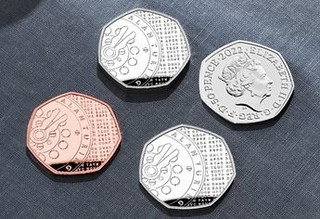 The Royal Mint has released a new collectable 50p coin to celebrate the life of British scientist and codebreaker Alan Turing.
The Royal Mint has released a new collectable 50p coin to celebrate the life of British scientist and codebreaker Alan Turing.
Computer genius Turing is best known for breaking the German Enigma code during World War Two, leading to victory over Nazi Germany.
Historians believe he may have shortened the war by four years - saving tens of thousands of lives.
 Turing already features on the new polymer £50 note - and now the Royal Mint are honouring him on a coin for the first time.
Turing already features on the new polymer £50 note - and now the Royal Mint are honouring him on a coin for the first time.
The 50p is available in gold, silver and base metal and was designed by artists Matt Dent and Christian Davies.
The reverse side of the coin features the name Alan Turing alongside an image of the Bombe machine used during the Second World War.
In a special nod to his work, the designers have incorporated hidden word sequences as part of the 50p design.
Each one represents a Turing quote and significant location, as well as the designers' initials.
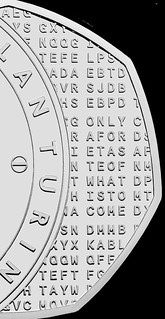 The coin is the final release in the Innovation is Science 50p series, which also features Charles Babbage, John Logie Baird, Rosalind Franklin and Stephen Hawking, and the Discovery of Insulin.
The coin is the final release in the Innovation is Science 50p series, which also features Charles Babbage, John Logie Baird, Rosalind Franklin and Stephen Hawking, and the Discovery of Insulin.
Can you spot the hidden messages? One came easy to me, but it's front and center in the design. The second one (first, reading left to right on the coin) is a phrase related to Cambridge University, where Turing studied. Never woulda guessed that one. Third are the designers initials. Once you see these, you can't unsee them. Not terribly well-hidden (by design, I'm sure), this code doesn't take a Turing-class genius to break. -Editor
To read the complete article, see:
Royal Mint releases new Alan Turing 50p coin - and it contains three secret messages
(https://www.mirror.co.uk/money/royal-mint-releases-new-alan-27413178)
MORTON & EDEN OFFER ALFRED WALLACE MEDALS
Morton & Eden will offer an extraordinary set of important medals awarded to one of the greatest scientists of the 19th century - Alfred Russel Wallace, a co-founder of and collaborator with Charles Darwin on the theory of evolution. Here's the press release. -Editor
Alfred Russel Wallace OM, FRS (1823-1913), was one of the greatest scientists and evolutionary thinkers of the modern era. Together with his contemporary Charles Darwin, Wallace is acknowledged as the co-founder of the theory of natural selection, more commonly termed today as evolution.
In recognition of his many scientific achievements, Wallace received a number of prestigious medals and awards during his lifetime including the important Darwin-Wallace medal in gold awarded by the Linnean Society of London (est: £10,000-15,000) and the Order of Merit (est: £12,000-£15,000).
These along with others from Wallace's collection are to be offered at auction in London by Morton & Eden on 20 July. The group of 9 significant medals will be sold individually with an overall collective estimate in excess of £52,000.
Sir David Attenborough first encountered Wallace's thrilling and indeed inspiring travel
books
when he was a young boy. In Sir David Attenborough's opinion; For me there is no
more admirable character in the history of science
. A naturalist, geographer, an intrepid
explorer, anthropologist, biologist, ornithologist, spiritualist, writer, poet and illustrator,
Wallace was also, like Sir David Attenborough, acutely aware of the potentially dangerous
environmental impact of human activity on our planet. Aside from many shared passions,
Sir David Attenborough, like Wallace, was also awarded the Order of Merit in addition to
being a Fellow of the Royal Society plus other shared learned societies.
James Morton, Director of Auctioneer's Morton & Eden, said: It is a huge honour to offer
these medals at auction. Medals of such historic significance are extremely rare and they bear testament to Wallace's enormous contribution to the revolutionary scientific
discoveries of the 19th century which remain hugely relevant today.
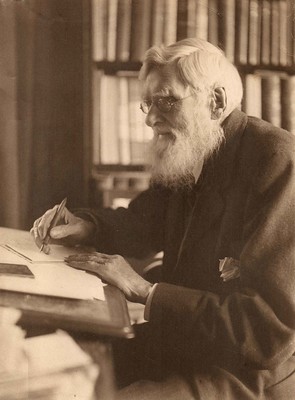 Wallace formed his theory of natural selection and the origin of species at the same time as
Charles Darwin was independently developing his own research into what has since become
more generally termed ‘evolution'.
Wallace formed his theory of natural selection and the origin of species at the same time as
Charles Darwin was independently developing his own research into what has since become
more generally termed ‘evolution'.
When Wallace sent Darwin a draft of his paper ‘On the Tendency of Varieties to Depart
Indefinitely From the Original Type' early in 1858, Darwin wrote despairingly all my
originality, whatever it may amount to, will be smashed
, so similar was Wallace's line of
thought to Darwin's own.
What then transpired, however, was that the two theories were presented together, Wallace's paper, together with extracts from Darwin's unpublished work, at the historic meeting of the Linnean Society on 1 July 1858.
What could have developed into a fierce professional rivalry in fact became, particularly on
Wallace's part, a relationship based on mutual respect and deference. Their relationship
was described by the President of the Linnean Society Dr D H Scott in 1908 as a generous
rivalry in which each discoverer strives to exalt the claims of the other...
.
In fact After Wallace's death in 1913 a portrait plaque by Albert Bruce-Joy was erected in Westminster Abbey in 1915, next to the existing memorial to Darwin, who had died in 1882.
One hundred years later in 2013, to mark the Centenary of Wallace's death, a bronze sculpture by Anthony Smith portraying the naturalist's 1859 pursuit of the spectacular Golden Birdwing butterfly was unveiled at the Natural History Museum, where many thousands of the specimens collected by Wallace in his expeditions are housed and studied.
A prolific writer, during his lifetime Wallace published numerous essays as well as more than 20 books including The Malay Archipelago (1869), Darwinism (1889) and his autobiography My Life (1905), as well as lesser-known works concerned with social criticism, Mesmerism, Spiritualism and even, as late as 1907, his consideration of possible extraterrestrial life in Is Mars Habitable?
Wallace, who lived to the great age of 90 was a pure scientist and never sought self-publicity. Ever modest concerning his own great achievements, Wallace famously remarked
to his editor that he had become rather tired of medals
, although his correspondence
reveals otherwise.
Wallace's medals are offered by direct descent. A spokesman for the vendor said: "Our family has had the pleasure and pride of owning these medals for over a century. However we feel now is the time for us to make them available to others who will appreciate their significance and the achievements of Alfred Russel Wallace as much as we do".
Included in the sale are a Royal Society Queen's Medal by William Wyon, a Royal Geographical Society Founder's Medal, in gold, also by William Wyon, and the Royal Society Copley Medal, in gold. What a fantastic opportunity to acquire some of the world's highest awards for scientific accomplishment, designed by the world's top engravers, and awarded to one of the world's greatest scientists? -Editor
For more information, see:
https://www.mortonandeden.com/
MEDALLIC REPRESENTATIONS OF DANCE
In a recent American Numismatic Society Pocket Change blog article, Scott Miller discusses medallic representations of dance. Here's an excerpt - see the complete article online for more great illustrations. -Editor
As with other forms of decorative art in turn of the century France, medals were a part of popular culture just as they were a part of the art world. Whether produced for widespread distribution, or in limited numbers, they remain as contemporary illustrations of iconic people and events which help define the popular idea of France during the Belle Époque. Though little known today, it should not come as a surprise that dancers were a common theme for medals created during the period. The Société des Amis de la Médaille Française (SAMF) was the brainchild of Roger Marx, who was employed by the French government as Inspecteur Général des Musées des Départements.
He was also one of the great promoters of decorative arts, including posters, prints, and medallic art. Founded in 1899, the SAMF issued several medals each year, examples of which were available for purchase by members in silver and bronze. A medal by Pierre Roche was issued at the time of the 1900 Universal Exposition then being held in Paris. It depicted Loïe Fuller, who was then performing at her own theater within the Exposition, designed by Henri Sauvage and which featured sculptures by Roche at the entrance. Her performances made innovative use of free movement, as well as color and lighting. The medal itself measures 71 mm. The obverse depicts Fuller dancing, along with her name, while the reverse depicts two calla lilies, crossed and elaborately tied with a ribbon, apparently in reference to Fuller's Lily Dance (fig. 5). A total of 275 medals were struck, of which 157 were in bronze and 109 in silver, with a small number in other metals.
The Cleveland Museum of Art has in its collection a number of items relating to Loïe Fuller, as well as several pieces donated by her. Included in the museum's collection are a pair of uniface casts of this medal, the obverse being 19.1 cm, and the reverse 18.1 cm (1978.120.a, 1978.121.a). Other Fuller-related items in their collection include a color lithograph by Henri Toulouse-Lautrec (1925.1202), a 53.4 cm high bronze statue of a standing Loïe Fuller, donated by the subject in 1917 (1917.368), a 1904 book by Pierre Roche entitled La Loïe Fuller (1995.54), and a 68 mm medal of Orpheus by Lucien Coudray, awarded to Loïe Fuller (1978.116).In 1912, Victor Canale published a 100 mm uniface plaque of a dancer by the then young sculptor, Henri Dropsy. In a 1964 catalogue of Dropsy's work, this medal was described as having been inspired by Isadora Duncan, who gave, at that time, memorable representations of dance. The medal depicts Duncan in her Greek inspired costume, dancing in the free-spirited style for which she was known.
Other medalists who approached dance as a subject for art medals did so as a generic theme, rather than illustrations of specific dancers. François Rupert Carabin, who created a series of six bronze figures depicting different phases of Loïe Fuller performing her Serpentine Dance, chose to depict a more generic image. Issued in 1901, this 50 mm medal was simply titled The Dance (fig. 9). On the obverse, Carabin depicts a woman on what appears to be a stage, while the reverse shows two couples dancing. Taking a different approach, Charles Pillet produced a plaquette for SAMF with the title Enfants (fig. 10). One side depicts four young children dancing in a circle, the models for which were probably his own children.
After World War I, medals began to lose popularity, and rarely depicted current, cultural trends. However, during that brief period, we think of as the Belle Époque, when artists, collectors, critics, performers, and the audience all came together, it is gratifying to know that medalists had their place at the table, next to a glass of absinthe.
To read the complete article, see:
Medallic Representations of Dance in Fin de Siècle France
(https://numismatics.org/pocketchange/dance/)
ALBERT WEINERT AND BAUMAN BELDEN
In another nice American Numismatic Society Pocket Change blog article, librarian David Hill discusses artist Albert Weinert and his plaque depicting ANS secretary, librarian (and later, Director) Bauman Belden. -Editor
I was talking with ANS fellow Scott Miller recently and mentioned to him an article I was working on about Bauman Belden, who was the Society's secretary and librarian before being named director in 1908, one of the ANS's first paid positions. Scott referred to a bronze plaque depicting Belden hanging in our Sage room. What?! This was news to me, though I have sat underneath that portrait many times. In my defense, Belden's name doesn't appear on the plaque. But the artist's name does: A. Weinert.
Albert Weinert (1863–1947) was a German-born sculptor who came to the United States in 1886. He produced a number of works in the round, including a sculpture of Cecil Calvert, Lord Baltimore, for a courthouse in Maryland and a battle monument at Lake George, New York. But he also did some notable works in relief. His stuccos of Grecian women adorn the rotunda of the Librarian's Room at the Library of Congress. After the Titanic went down he created a tablet memorializing the band that played as the ship sank.
I was delighted to discover a file of correspondence in the ANS Archives between him and Belden in 1913-1914. Weinert lived and worked in New York but was in San Francisco when he wrote the letters, preparing for the Panama-Pacific International Exposition that would take place in 1915. The work on the Fair-Grounds has first begun and we are modelling large pieces of sculpture in Plaster of Paris, in imitation of the travertino, the soft porous stone, used in the interior of the Pennsylvania station,
he wrote. I am working with young men from different ateliers and studios from all over the states and it is fascinating to see the work grow
(July 26, 1913).
Belden and Weinert were on the friendliest terms, the two trading long, descriptive letters, with Weinert describing a flower-filled Golden Gate Park, a band playing and crowds milling about in the sparkling sunny air,
and Belden telling of trout fishing in the Pennsylvania mountains (July 26, August 6, 1913). Weinert also mentions dining at San Francisco's Bohemian Club with painters Childe Hassam and William de Leftwich Dodge. As far as he was concerned, The Bohemian Club, Mount Tamalpais, and the Greek Theatre in Berkeley cannot be rivaled in the East
(February 28, 1922).
With a little investigating, I found that, besides the plaque in the Sage room, we had a couple more Weinert items in the ANS collection: a smaller version of the Belden plaque, donated by Belden in 1914, and a bronze portrait of a young woman, unidentified in our catalog, but verified as being Helen Dodd in the American Journal of Numismatics (1913, v.47, pl.10).
To read the complete article, see:
Albert Weinert and Bauman Belden
(https://numismatics.org/pocketchange/weinert/)
HOOVER SERVANT TO THE HOME MEDALS
Tucked away among family mementoes is a metal paddle with a wooden handle looking sort of like a swatter for giant flies. It's a carpet beater, an essential appliance in the modern 19th century home. It belonged to one of my grandmothers. Back in the day the regular household cleaning chores included hauling carpets outside, draping them over a line, and whacking them with the carpet beater - producing a big cloud of dust and a somewhat cleaner carpet to be hauled back into the room where it came from.
And where were the menfolk while this chore took place? Working at the mills, spewing filth into the skies, which eventually found its way into everyone's lungs, houses ... and carpets - the Circle of Life for dirt.
And in the early 20th century a savior appeared - the vacuum cleaner. The handy appliance we take for granted today was the hot new technology when it first appeared. And women whacked their men with the carpet beaters until they bought one for the house. They had Popeye biceps and a mean swing after all that practice, and the newfangled electric carpet cleaners flew out of the factories like the latest iPhone.
The Apple of the day was The Hoover Company. Their advertising slogan? "SERVANT TO THE HOME". Think "magic genie who does all the work for you", just like "AUTOPILOT" does all the driving for you in your new Tesla, while you sit back, relax and ignore the freight train approaching the crossing ahead.
Every good product needs a mascot, and the company went to work bringing their genie to life. Harry Waterson published a nice article on the Hoover company's SERVANT TO THE HOME medals in the January 2022 issue of The Clarion from the Pennsylvania Association of Numismatists. With permission, we're publishing an excerpt here. Thanks to Harry and Clarion editor Rich Jewell for their assistance. -Editor
The Electric Suction Sweeper Company was a successful manufacturer and marketer of vacuum cleaners founded in 1908 in N. Canton OH. In 1915, it became the Hoover Suction Sweeper Company and finally The Hoover Company in 1922.
The company had a famous slogan coined by Gerard Page-Wood in 1919. It BEATS . . . as it Sweeps . . . as it Cleans.
The motto was used on nameplates for its various sweeper products. However, it did not lend itself to a graphic design for the company. This Hoover advertorial appeared in January 1923,
Someday there will be no servants in the world but mechanical ones. Everyone will have servants but they will not be human. . . . And nothing in the way of a household appliance has advanced so quickly and become a permanent fixture in the home as the Electric Sweeper.
On August 21, 1923, The Hoover Company received registration for SERVANT TO THE HOME as a word mark. Later that fall, Gerald Page-Wood, the art director for Erwin, Wasey & Co., Hoover's ad agency, together with Albin Polacek, Director of Sculpture at the Chicago Art Institute, conducted a contest for a medallion that could be used by Hoover as a symbol for laborsaving devices for freedom from drudgery.
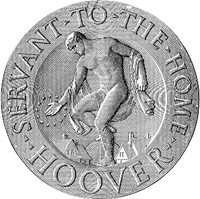 The design selected embodied a powerful, though benign, stooping figure bestowing the benefits of electricity onto the homes beneath his hand. Electricity was the mythical significance of the aura of stars about the figure's left hand. The lower part of the circle was occupied by the words SERVANT TO THE HOME. This medallion had been designed so it could represent a number of products Hoover might someday produce.
The design selected embodied a powerful, though benign, stooping figure bestowing the benefits of electricity onto the homes beneath his hand. Electricity was the mythical significance of the aura of stars about the figure's left hand. The lower part of the circle was occupied by the words SERVANT TO THE HOME. This medallion had been designed so it could represent a number of products Hoover might someday produce.
Miss Josephine Marie Kern, a student at the Chicago Art Institute, won the contest. She received a first prize of $1,000 and her design was cast as a 4 1/2-inch bronze medallion.
Harvey Hopkins Dunn (1883-1952), a well-known World War One artist, magazine illustrator and typeface designer did a pen and ink drawing of Kern's design for use in advertising and printed materials.
There are two discrepancies between the description of Kern's design and Dunn's drawing. The two dies cut for the medal by Medallic Art Co. illustrate this. They are reciprocating dies. The central device is flipped from left to right and the upper and lower legends are switched from top to bottom. Since dies were cut, examples must exist of both varieties. The description of Kern's design describes the 4 1/2-inch bronze medallion, which has the figure facing right and SERVANT TO THE HOME as the lower legend.
These images are from the Medallic Art Company database on the American Numismatic Society website. Images courtesy American Numismatic Society, MACO Archives. They illustrate the flip-flop and legend switch. They are MACo #1924-024 (1 3/8-inch diameter) to the right and MACo #1924-024-001 (1&3/16-inch diameter) to the left. Both are bronze and have mostly plain reverses.
The above medal is the springboard for this article. It is bronze, 1 3/8-inches in diameter and suspended from an orange and black ribbon with a crimp-back brooch at the top. It is edge marked MEDALLIC ART CO. N.Y. The obverse depicts a carefully draped nude male figure balancing on his left foot amid the rooftops of a small village, all in a shallow depression. He is holding out a helping hand outlined with stars. •SERVANT•TO•THE•HOME• fills the upper border with •HOOVER• below. It is signed JOSEPHINE KERN in tiny letters just within the depression at the ME of HOME.
The reverse has a decorative garniture at the top with a 2-line inscription just below: THE HOOVER COMPANY / MAXIMAN A third of a laurel wreath is at the bottom with a stylized capital H in a box at the center. The empty space above the wreath is engraved in 2-lines on center: / D. F. MOSES /1932.
In 1926, The Hoover Company introduced their new 700 series vacuum cleaner and this machine was state of the art. On the back page of the cleaner's manual was Harvey Dunn's pen & ink drawing which that year became a registered trademark of the company. This Servant To The Home image is cast into the top of the motor housing of every Model 700 vacuum cleaner made in the U.S. from 1926 to 1929. The Hedlite Model also has the same image on top. The 700 series made in Canada for export to the United Kingdom has the Royal Coat of Arms on the top of the motor housing.
The SERVANT TO THE HOME image was also used on employee passes and lapel pins.
The brass employee pass is 34mm at it widest with no maker's mark. It is pierced at the top. This pass was the first one seen by the Hoover Historical Center. When and how it was used is a subject for further research.
The Medallic Art Company made this small sterling silver lapel pin. MACo #1924-024-002. It is 3/4 of an inch across and has a locking pin keeper on the back. The lapel pin is something a salesman might have received when he sold his first electric sweeper.
The SERVANT TO THE HOME emblem also appeared on large circular bas-reliefs just below the arch above the front doors of the company gatehouses. These bas-reliefs are close to three feet wide. The gatehouses were pedestrian entrances and they flanked the breezeway of the vehicular entrance to the Hoover plant. The driveway was signposted General Office Entrance. The 10-foot friezes were installed in 1925 and were there until the gatehouses were torn down in 1968.
Harry adds:
"Apropos of the 4th of July, Josephine Marie Kern was the maternal granddaughter of George Frederick Root. He wrote the Civil War patriotic hit, Yes we'll rally round the flag, boys, we'll rally once again."
The complete article has much more, including a bio of artist Josephine Marie Kern, the Hoover Maximan medal, a SERVANT TO THE HOME version used in England, and this unique group of medals awarded to C. W. Dean (photo credit Robin Clay). Thanks again for the great research! -Editor
For more information on PAN, see:
https://pancoins.org/
THE BOOK BAZARRE
2022 FIELDS MEDAL WINNERS
Nobel Prize medals may be the most famous medals in the world, but they aren't the only important medals for achievment at the highest level. We've written before about the Fritz Medal for engineering and the Fields Medal for mathematics. This week, four new Fields medals were awarded. First, some background. -Editor
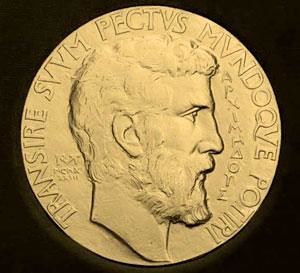 The Fields Medal is often referred to as the mathematical equivalent of the Nobel Prize, but it is granted only every four years and is given, by tradition, to mathematicians under the age of 40, rather than to more senior scholars.
The Fields Medal is often referred to as the mathematical equivalent of the Nobel Prize, but it is granted only every four years and is given, by tradition, to mathematicians under the age of 40, rather than to more senior scholars.
The Fields Medal originated from surplus funds raised by John Charles Fields (1863–1932), a professor of mathematics at the University of Toronto, as organizer and president of the 1924 International Congress of Mathematicians in Toronto. The Committee of the International Congress had $2,700 left after printing the conference proceedings and voted to set aside $2,500 for the establishment of two medals to be awarded at later congresses.
Following an endowment from Fields's estate, the proposed awards—contrary to his explicit request—became known as the Fields Medals. The first two Fields Medals were awarded in 1936. An anonymous donation allowed the number of prize medals to increase starting in 1966. Medalists also receive a small (currently $1,500) cash award.
To read the complete article, see:
Fields Medal mathematics award
(https://www.britannica.com/science/Fields-Medal)
The medal was designed by Canadian sculptor R. Tait McKenzie.
QUICK QUIZ: The Carnegie Hero Medal shows Andrew Carnegie on the obverse; the John Fritz Medal shows John Fritz; so who's the guy on the Fields medal? And have any of the Fields medals come out on the numismatic market? -Editor
To read some fascinating stories about the 2022 winners, see:
In Times of Scarcity, War and Peace, a Ukrainian Finds the Magic in Math
(https://www.quantamagazine.org/ukrainian-mathematician-maryna-viazovska-wins-fields-medal-20220705/)
He Dropped Out to Become a Poet. Now He's Won a Fields Medal.
(https://www.quantamagazine.org/june-huh-high-school-dropout-wins-the-fields-medal-20220705/)
For His Sporting Approach to Math, a Fields Medal
(https://www.quantamagazine.org/hugo-duminil-copin-wins-the-fields-medal-20220705/)
A Solver of the Hardest Easy Problems About Prime Numbers
(https://www.quantamagazine.org/number-theorist-james-maynard-wins-the-fields-medal-20220705/)
To read earlier E-Sylum articles, see:
RUSSIAN WINNER SNUBS FIELDS MEDAL
(https://www.coinbooks.org/esylum_v09n35a10.html)
QUIZ ANSWER: FIELDS MEDAL DESIGNER R. TAIT MCKENZIE
(https://www.coinbooks.org/esylum_v17n35a21.html)
STANFORD PROFESSOR AWARDED FIELDS MEDAL
(https://www.coinbooks.org/esylum_v17n34a16.html)
2022 MEDALS OF FREEDOM AWARDED
It's that time of year again, folks - the Presidential Medal of Freedom ceremony. Here's an excerpt from Washington Post coverage of Thursday's White House event. -Editor
Clockwise from left, businesswoman Laurene Powell Jobs, former congresswoman Gabby Giffords, Gold Star father Khizr Khan and lawyer Fred Gray
President Biden on Thursday awarded the Presidential Medal of Freedom, the nation's highest civilian honor, to 17 people in a wide variety of endeavors, including gymnast Simone Biles, Academy Award-winning actor Denzel Washington and, posthumously, inventor Steve Jobs and former senator John McCain.
Welcoming the recipients in the White House East Room, Biden called them an extraordinary, extraordinary group of Americans
who strive for the idea of America as the the cause of freedom shines like the sun to light up the future of the world.
The honorees range from Biles, 25, the most decorated U.S. gymnast in history, who has advocated for sexual assault victims, to former senator Alan Simpson (R-Wyo.), 90, the sharp-tongued politician and governor's son who served 18 years in the Senate and was outspoken on the issue of fiscal responsibility.
Of Biles, Biden joked, Today, she adds to her medal count of 32.
Biden's list of political honorees includes Republicans and Democrats. Former representative Gabrielle Giffords (D-Ariz.) co-founded Giffords, a nonprofit focused on preventing gun violence, after she was shot in the head at a constituent event in Tucson in January 2011 and gravely wounded. She is married to Sen. Mark Kelly (D-Ariz.), a former astronaut, who is up for reelection this year.
From foster care challenges to gun violence, the recipients have witnessed up close some of the darkest elements of the American experience. But their triumphs over adversity are what makes them worthy of the nation's greatest honor, Biden said.
Gabby is one of the most courageous people I have ever known,
he said.
One of the most decent, stand-up, genuine guys I've ever served with — and I serve with a lot of senators — is this guy,
Biden said, referring to Simpson. Alan Simpson is the real former United States senator from his beloved Wyoming.
Jobs, who died of cancer in 2011, was co-founder and chief executive of Apple, whose company's inventions revolutionized the lives of billions of people worldwide.
The list also includes Khizr Khan, a Gold Star father who has been an advocate for the rule of law and religious freedom while serving on the U.S. Commission on International Religious Freedom; and Gen. Wilma Vaught, one of the most decorated women in the history of the U.S. military.
Biden honored Fred Gray, one of the first Black members of the Alabama legislature since Reconstruction and an attorney who represented civil rights activists such as the Rev. Martin Luther King Jr. and Rosa Parks, along with the NAACP. Other honorees include Raúl Yzaguirre, a civil rights advocate who served as chief executive and president of National Council of La Raza for 30 years, and Diane Nash, a founding member of the Student Nonviolent Coordinating Committee.
Biden praised Gray's contribution to helping dismantle unjust laws, working as one of the civil rights movement's most respected lawyers.
Fred's legal brilliance of strategy desegregated schools and secured the right to vote,
the president said. … An ordained minister, he imbued a righteous calling that touched the soul of our nation.
To read the complete article, see:
Biden honors 17 people with Presidential Medal of Freedom
(https://www.washingtonpost.com/politics/2022/07/07/biden-freedom-medals-rapinoe-denzel-washington/)
For more on Fred Gray, see:
Fred Gray, the ‘chief counsel for the protest movement,' to get Medal of Freedom for his civil rights work
(https://theconversation.com/fred-gray-the-chief-counsel-for-the-protest-movement-to-get-medal-of-freedom-for-his-civil-rights-work-186103)
STOLEN GOLD MEDAL RETURNED TO OLYMPIAN
It wasn't a rock - it was a genuine Olympic gold medal that an Anaheim, CA woman found among trash while walking her dog. -Editor
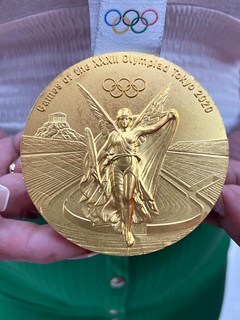 Maria Carrillo stepped outside the back door of her office to walk her two dogs one evening when she noticed a plastic fast-food bag had been dumped on her property.
Maria Carrillo stepped outside the back door of her office to walk her two dogs one evening when she noticed a plastic fast-food bag had been dumped on her property.
When she picked up the McDonald's bag, it felt heavy and she thought there might be a rock inside.
She opened it and saw an object gleaming in the middle of the crinkled hamburger wrappers and empty french-fry boxes. It looked exactly like an Olympic gold medal.
She pulled it out and saw the words Games of the XXXII Olympiad Tokyo 2020,
as well as the five Olympic rings and the Greek goddess Nike.
My first thought was, ‘This is so beautiful — is it for real?'
she said about her June 27 discovery.
The discarded medal and the red, white and blue ribbon attached to it were in excellent condition, Carrillo said.
She phoned her husband, Noe Hernandez, 49, who runs Noel Barber Shop nearby, and he told her that the medal was likely fake. Carrillo decided to hurry over to his shop so he could see it. To her, it looked real.
Noe has a friend who works for the police department, and it turned out he was coming in for a haircut,
Carrillo said. As soon as [the officer] saw it, he told my husband it was real and that it had been stolen.
We were like, ‘Oh my God, this is really somebody's Olympic gold,'
added Hernandez.
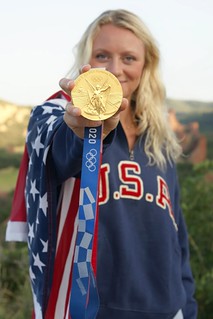 Police checked their files and told the couple that the gold medal belonged to Jordyn Poulter, the starting setter of the 2020 U.S. Women's Volleyball Team. On May 25, she had reported it stolen from her car while it was parked in her garage in Anaheim.
Police checked their files and told the couple that the gold medal belonged to Jordyn Poulter, the starting setter of the 2020 U.S. Women's Volleyball Team. On May 25, she had reported it stolen from her car while it was parked in her garage in Anaheim.
Poulter said she had mistakenly left it there one day after she had been carrying it around with her to show it to friends.
Poulter and her teammates won the medal in the Summer Olympics after they beat longtime rival Brazil, and took home Olympic gold for the first time in the team's history.
I thought my medal was long gone,
Poulter added. I made peace with the fact that I'd probably never see it again.
To me, my medal was priceless,
she said.
I'm thinking I'll send [the medal] home to my parents' house in Denver and let them look after it,
said Poulter.
As for Carrillo, she said she won't look at a bag of trash in quite the same way again.
To read the complete article, see:
Out walking her dogs, she found an Olympic gold medal on the ground
(https://www.washingtonpost.com/lifestyle/2022/07/07/olympic-gold-medal-volleyball-poulter/)
THE FIRST NATIONAL BANK OF MCCONNELSVILLE
I learned an interesting fact from this week's Featured Website. This article from the Office of the Comptroller of the Currency discusses the oldest national bank still operating under the same name and the same OCC charter - First National Bank of McConnelsville, Ohio. -Editor
The First National Bank of McConnelsville in southeastern Ohio is the oldest national bank still operating under the same name and the same OCC charter—number 46, to be exact.
As of the first quarter of 2013, the bank had $141 million in assets and several branches in neighboring towns. But the town remains about the same size—under 2000 inhabitants—as in 1863. Bank accounts and shares of stock have been handed down through families from the time the bank was launched.
The bank opened its doors in the same year Congress created the national bank system and the North defeated the South in the battle of Gettysburg. Founded with capital of $75,000, the bank greeted customers at its original location—32 East Main Street, on the town square—for more than a century. A Greek Revival-style courthouse, standing across the street from the bank in 1863, is still there today.
Also on Main Street is the Evelyn True Button House, a red brick house built in 1836 and now the site of a historical society. It displays an artifact from Morgan's Raid—the northernmost uniformed Confederate attack on the north—that struck McConnelsville in July 1863, the same month the bank opened on the town square.
On April 19, 1864, a federal examiner visited the newly-created bank and wrote a report to Comptroller of the Currency Hugh McCulloch in the Washington headquarters: "Dear Sir, I have today examined The First National Bank of McConnelsville." He found assets of $224,744.67, a "stone and brick vault" and a "burglar-proof safe." "The directors are mostly in active business and are men of moderate means." The examiner said he instructed the bank on matters involving lending and record-keeping.
The entire report resided on two handwritten sheets of paper. A sheet of about eight-by-eight inches listed the bank's assets and liabilities; another of about eight by ten contained the comments. Two pages, one man, one day—that was the typical community bank exam in the 1860s.
 The McConnelsville bank has outlived the first entry on the national bank charter list, the First National Bank of Philadelphia. The Philadelphia bank was founded by another Ohio native, financier Jay Cooke, and had six times the assets of its counterpart in McConnelsville. After the Civil War, the McConnelsville bank helped market railroad bonds issued by Cooke and his new business partner, Hugh McCulloch—the same McCulloch who, as the first Comptroller, oversaw the bank's supervision at its inception.
The McConnelsville bank has outlived the first entry on the national bank charter list, the First National Bank of Philadelphia. The Philadelphia bank was founded by another Ohio native, financier Jay Cooke, and had six times the assets of its counterpart in McConnelsville. After the Civil War, the McConnelsville bank helped market railroad bonds issued by Cooke and his new business partner, Hugh McCulloch—the same McCulloch who, as the first Comptroller, oversaw the bank's supervision at its inception.
First National Bank of McConnelsville has grown exponentially since 1863. But its name and number remain the same.
To read the complete article, see:
Longest-Lived: Ohio Community Bank Has Same Name and Charter Number after 150 Years
(https://www.occ.gov/about/who-we-are/history/1863-1865/1863-1865-longest-lived.html)
I reached out to Peter Huntoon for images of the bank's paper money, and he kindly provided a number of images and additional information on the sequence of events around the loss and restoration of the bank's original charter number. Thank you! -Editor
The First National Bank of McConnelsville, charter number 46
chartered: July 31, 1863
liquidated: May 31, 1882
The cause for the liquidation was that the original corporate life chosen by the bankers was less than 20 years (probably 19 years) as per the terms of the Act of February 25, 1863 under which the bank was organized, so the bankers had no choice but to liquidate because the Act of July 12, 1882, which provided for a first 20-year extension, was not passed in time to allow for the bank to be extended.
The bankers reorganized their bank with the same title under new charter number 2712
organized: Apr 12, 1882
chartered: May 31, 1882
After the turn of the 20th century, the Comptroller of the Currency's office provided a procedure whereby bankers whose banks were caught in this dilemma could petition to have their early charter number restored; however, that restoration was totally cosmetic allowing them to use their original charter number, but the organization date associated with the bank would remain the date associated with the higher charter number. Thus, they forever lost the first 20 years of their corporate life.
Restoration of charter 46 to 2712 using the same title
restoration: June 8, 1911
For more information on the bank, see:
https://www.first-national.com/about/
TITANIC COIN AND PAPER MONEY DISPUTED
A court is sorting out ownership issues around numismatic artifacts recovered from the wreck of the Titanic. -Editor
The caretakers of the Titanic are battening down the hatches for a court battle to prevent four artifacts recovered from its wreckage site from going up for auction.
A British gold coin, two US bank notes and a block of coal retrieved decades ago from the detritus of the doomed passenger liner wrongly fell into the hands of a company that is trying to auction them off, claims RMS Titanic Inc., which owns the salvage rights to the ship and is suing to stop the auction.
RMS Titanic is the steward and custodian
of the wreck, and claims in Manhattan Supreme Court papers that one of its former execs, G. Michael Harris, took the artifacts, which were then sold off to Mobile Grocers of America Inc. when Harris later filed for bankruptcy.
Harris claimed the four items had been gifted to him by another Titanic exec, George Tulloch, with whom he frequently butted heads, the group charges in court papers.
RMS Titanic contends Tulloch had no right to gift the artifacts to anyone.
The coin and the paper currency were recovered during a 1987 expedition to the wreck site in the North Atlantic, and the chunk of coal was retrieved during a 1994 dive, according to the legal filing.
A preview by UES auction house Guernsey's trumpeted that the items — billed as The Saga of Four Titanic Treasures
— would be part of an online sale in the late spring, 2022.
Guernsey's agreed to put the auction on hold after lawyers from RMS Titanic Inc reached out, according to court papers.
To read the complete article, see:
Titanic caretakers in court battle to stop artifacts from being sold
(https://nypost.com/2022/07/09/titanic-caretakers-in-court-battle-to-stop-artifacts-from-being-sold/)
To read the earlier E-Sylum article, see:
A GLIMPSE OF PAPER MONEY FROM THE TITANIC
(https://www.coinbooks.org/esylum_v13n33a20.html)
LOOSE CHANGE: JULY 10, 2022
Here are some additional items in the media this week that may be of interest. -Editor
Greg Reynolds published a nice Greysheet article on the historical impact of the first 3-cent silver pieces. See the complete article online. -Editor
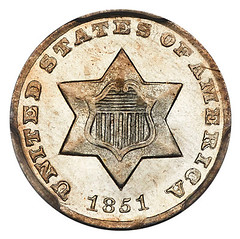 The law that authorized Type 1 Three Cent Silvers led to a permanent change in the monetary order of the United States. In the United States, silver was never again regarded as money to the extent that it was before trimes were minted.
The law that authorized Type 1 Three Cent Silvers led to a permanent change in the monetary order of the United States. In the United States, silver was never again regarded as money to the extent that it was before trimes were minted.
Three Cent Silvers are unlike Three Cent Nickels, which were minted from 1865 to 1889. Three Cent Nickels do not contain any silver and Three Cent Silvers do not contain any nickel.
Type 1 Three Cent Silvers were minted from 1851 to 1853. Type 2 Three Cent Silvers were introduced in 1854, and the third type began in 1859. The distinctions between Type 2 and Type 3 Three Cent Silvers are not as significant as the differences between Type 1 and Type 2 coins.
To read the complete article, see:
The Huge Historical Impact of Type 1, 3-Cent Silvers
(https://www.greysheet.com/news/story/the-huge-historical-impact-of-type-1-3-cent-silvers)
An article on the PCGS site discusses the origins of the Yuan Shikai dollar. -Editor
Expelling the foreign silver coins from China, the Yuan Shikai Dollar became a turning point for Chinese coins. During the late Qing Dynasty in China, the foreign currency inside the nation caused havoc. The government of the Qing Dynasty had lost both control and autonomy over the circulating coinage in China with more than 100 different circulating Chinese and foreign currencies in circulation in the country. With this system of exchange, it caused issues with both fixed exchange and taxation, leaving the general public exasperated with the system. In 1914, the National Currency Regulations were put into effect to produce a new currency on the silver standard. President Yuan Shikai saw this opportunity to place his portrait on this new currency to solidify and propagate himself and his political status by means of this new currency.
For the design of Yuan Shikai, the Italian engraver L. Giorgi was employed to model the obverse. From photographs, Giorgi designed a coin featuring a portrait-facing 70% from view. After struck patterns of the coin were produced, Giorgi made the trip to Beijing to meet the president. After meeting President Yuan Shikai, Giorgi found his work not true to the spirt of the president, causing him to do a full redesign of his image to that of a profile of the much larger man he had met. This design gave birth to the circulation-issue Yuan Shikai Dollar that would propagate China until 1951.
To read the complete article, see:
The Origin of the Yuan Shikai Dollar
(https://www.pcgs.com/news/the-origin-of-the-yuan-shikai-dollar)
A CoinWeek article by Michael Shutterly discusses the anonymous folles of Byzantium. -Editor
Imperial Byzantine coinage served both economic and propaganda purposes. The coins routinely identified the reigning emperor or empress by name and title, and usually portrayed the ruler in some vigorous pose that demonstrated power and authority.
One great exception was the copper coinage that began to appear circa 969 and endured until circa 1092. The Anonymous Folles
bore neither name nor portrait, nor any other identifying information about the ruler who struck them. In fact, there is no bronze or copper coinage that names or portrays any Byzantine ruler from John I Tzimiskes (reigned 969-976) through Isaac I Komnenos (reigned 1057-1059).
Anonymous Folles continued to appear alongside named
bronze coinage of the emperors Constantine X (reigned 1059-1067), Romanos IV Diogenes (reigned 1068-1071), Michael VII Dukas (reigned 1071-1078), Nikephoros III Botaniates (reigned 1078-1081), and Alexios I Komnenos (reigned 1081-1118). The series finally ended with the coinage reform that Alexios I launched in 1092.
To read the complete article, see:
CoinWeek Ancient Coins – The Anonymous Folles of Byzantium
(https://coinweek.com/ancient-coins/coinweek-ancient-coins-the-anonymous-folles-of-byzantium/)
Bibliophiles, especially those of a certain age, will enjoy this essay on the late lamented physical card catalog. -Editor
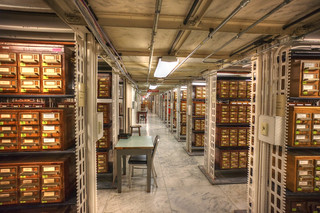 Depending on your age, you might remember the tiny envelope with the stamp card in the back of your library book. That, friends, is a remnant of the Dewey Decimal System, a relic of the card catalog used in libraries for 200 years. In the age of the internet, one would think that the obsolete card catalogs have disappeared, but true to form, collectors dedicated to organizing written volumes have turned to collecting the organisation forms themselves.
Depending on your age, you might remember the tiny envelope with the stamp card in the back of your library book. That, friends, is a remnant of the Dewey Decimal System, a relic of the card catalog used in libraries for 200 years. In the age of the internet, one would think that the obsolete card catalogs have disappeared, but true to form, collectors dedicated to organizing written volumes have turned to collecting the organisation forms themselves.
The Library of Congress still holds its entire (paper) card catalog, which is currently gathering dust in the basement, essentially a relic abandoned by modern society. Supposedly, they keep it there for older patrons who occasionally use it, but the catalog remains an important historical archive.
The more modern system that was used in libraries up until about the end of the 2000s, started with a catalog of cards to manage the personal book collection of Francis Ronalds, a 19th century English scientist and inventor, who pioneered the first practical use of this system. The mid 1800s saw the Italian publisher, Natale Battezzati develop a similar card system for booksellers wherein cards represented authors, titles, and subjects.
To come full circle, the internet now has websites that offer ways to Re-use a Card Catalog. On Amazon, you can purchase a reproduction of a nostalgic library box tray, complete with 30 notecards and tabbed dividers. The aptly-named brand, Out of Print, has an entire Library collection including tote bags, socks and drink sleeves inspired by the card catalog to express your love of the stacks.
To read the complete article, see:
An Ode to the Card Catalog
(https://www.messynessychic.com/2022/05/25/an-ode-to-the-card-catalog/)
ROYAL MAIL ADDS BARCODES TO STAMPS
I guess we should have known this was coming - the U.K.'s Royal Mail has stamps with digital barcodes that will allow people to track their mail online. -Editor
To send a hand-written letter is to take a break from today's digital world, says Dinah Johnson. So when she heard about the U.K. Royal Mail was adding barcodes to their stamps, she wasn't exactly thrilled.
The new stamps, unveiled earlier this year, allow correspondents to track their letters and share link photos and videos by scanning the digital barcodes with an app.
Johnson, founder of the Handwritten Letter Appreciation Society, said she acknowledges the benefits of technology. But she feels tech is forcing itself onto an age-old pastime.
"I feel a bit affronted about my letter being tracked, because there's something so pure and simple about letter writing and then the digital world has been kind of forced on it," Johnson told As It Happens guest host Ginella Massa.
The change will only affect "definitive" stamps, which are the regular-issued stamps of a country. Collectors' stamps with art and photos will remain the same. Non-barcoded definitive stamps will remain valid until Jan. 31, 2023. After that, people can swap their old stamps for new ones.
The beauty of letter-sending for Johnson is not knowing exactly when your letter will reach its destination, or when you'll receive one from someone else.
"The romance of it is that you don't know whether it'll ever get there. You send it out into the world and you hope it will," she said. "You leave it in the hands of the postal services and they do this amazing job."
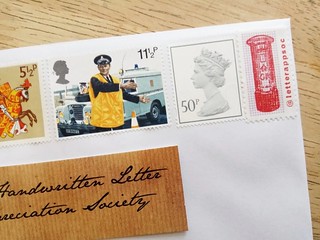 To further express her frustration with the new stamps, Johnson has been placing customized stickers over the barcodes of letters she receives so she doesn't have to look at them.
To further express her frustration with the new stamps, Johnson has been placing customized stickers over the barcodes of letters she receives so she doesn't have to look at them.
Johnson's friend, who owns a printing press, made a design of a postbox with her organization's Twitter handle on it. In an interview with The Guardian, she called it her "mini private protest."
"I didn't want to be seen to be defacing Royal Mail stamps," she said. "I wasn't out to do that."
But she did it, and the letter arrived at its intended location safe and sound. A Royal Mail spokesperson told the Guardian that covering the barcodes is probably fine until January 2023, but after that, it will be "an essential part of the stamp."
Paper money has long had serial numbers, and private citizens can volunteer to track them via sites like Where's George. And I wouldn't be surprised if some money-counting machines have features that can read and flag notes sought by officials investigating kidnappings, money laundering and like crimes. But I doubt such a feature will come to coins anytime soon. When you spend a coin, it ceases to be yours. But when you mail a letter, it remains yours and you do care about whether and when it arrives at its destination. And the post office, encharged with delivering it for you, also has an interest in knowing where each piece is.
Affordable tracking technology didn't exist until recent times, but now that it's here its use is inevitable. My wish? Find a better way to encode the tracking number so it's not intrusive to the user. These Nintendo-style barcodes are like the hefty, blocky brick mobile phones of the 1980s, and perhaps someday they'll morph into something more discreet and pleasant to see. Or not see at all. -Editor
To read the complete article, see:
Barcodes on British stamps draw the ire of hand-written letter aficionados
(https://www.cbc.ca/radio/asithappens/as-it-happens-tuesday-edition-1.6510937/barcodes-on-british-stamps-draw-the-ire-of-hand-written-letter-aficionados-1.6510940)
FEATURED WEB SITE: COMPTROLLER OF THE CURRENCY
This week's Featured Web Site is the Office of the Comptroller of the Currency, suggested by Tom Kays. Thanks!
The OCC charters, regulates and supervises all national banks and federal savings associations and ensures that they operate in a safe and sound manner, provide fair access to financial services, treat customers fairly, and comply with applicable laws and regulations.
Created as a bureau of the U.S. Department of the Treasury by the National Currency Act of February 25, 1863, the Office of the Comptroller of the Currency celebrated its 150th anniversary in 2013.
Tom writes:
"I am putting together a talk about old coins and discovered a great website of interest. See the Office of the Comptroller of the Currency website at www.occ.gov for a nice virtual encapsulation about the trials and triumphs of furnishing paper money to America."

